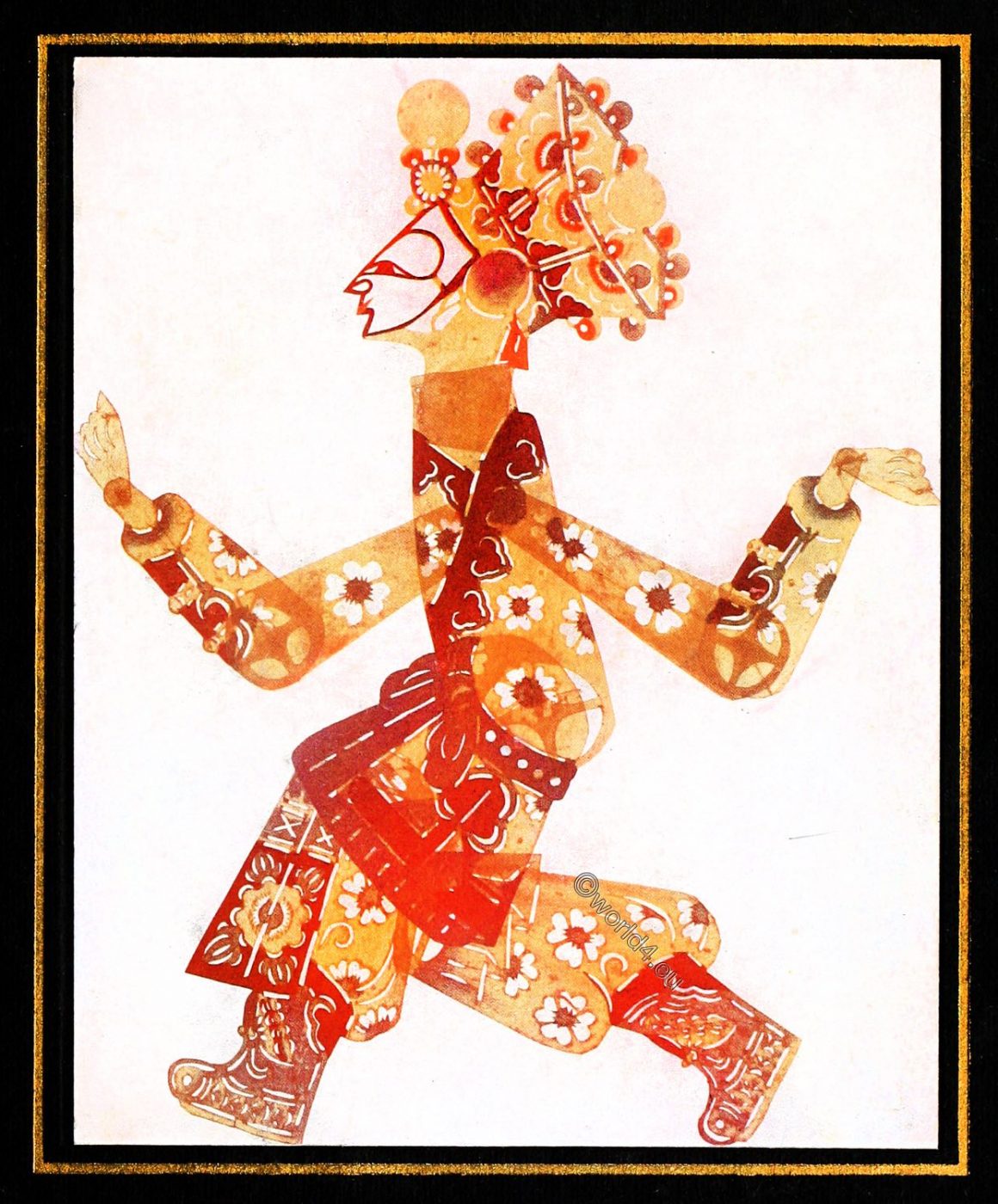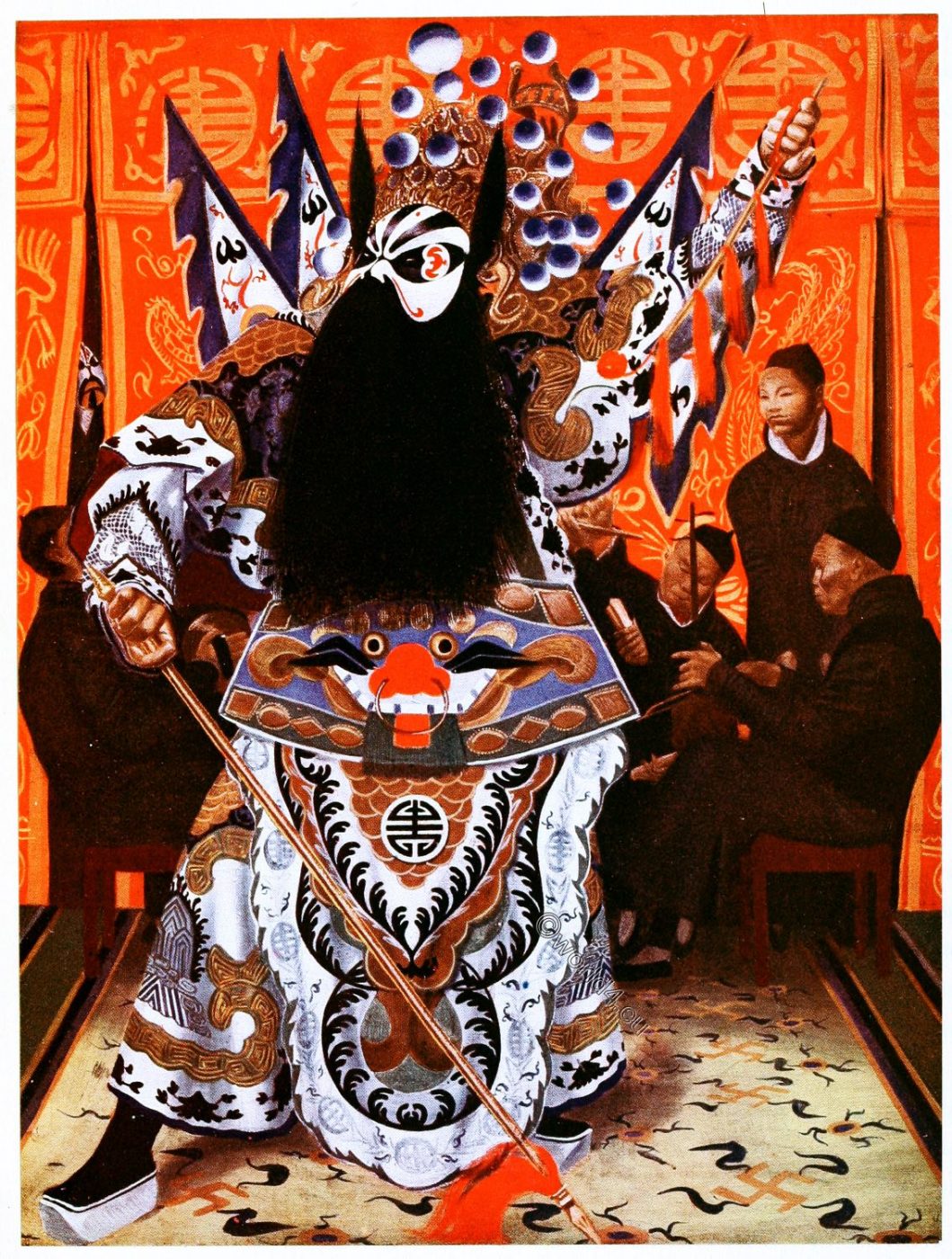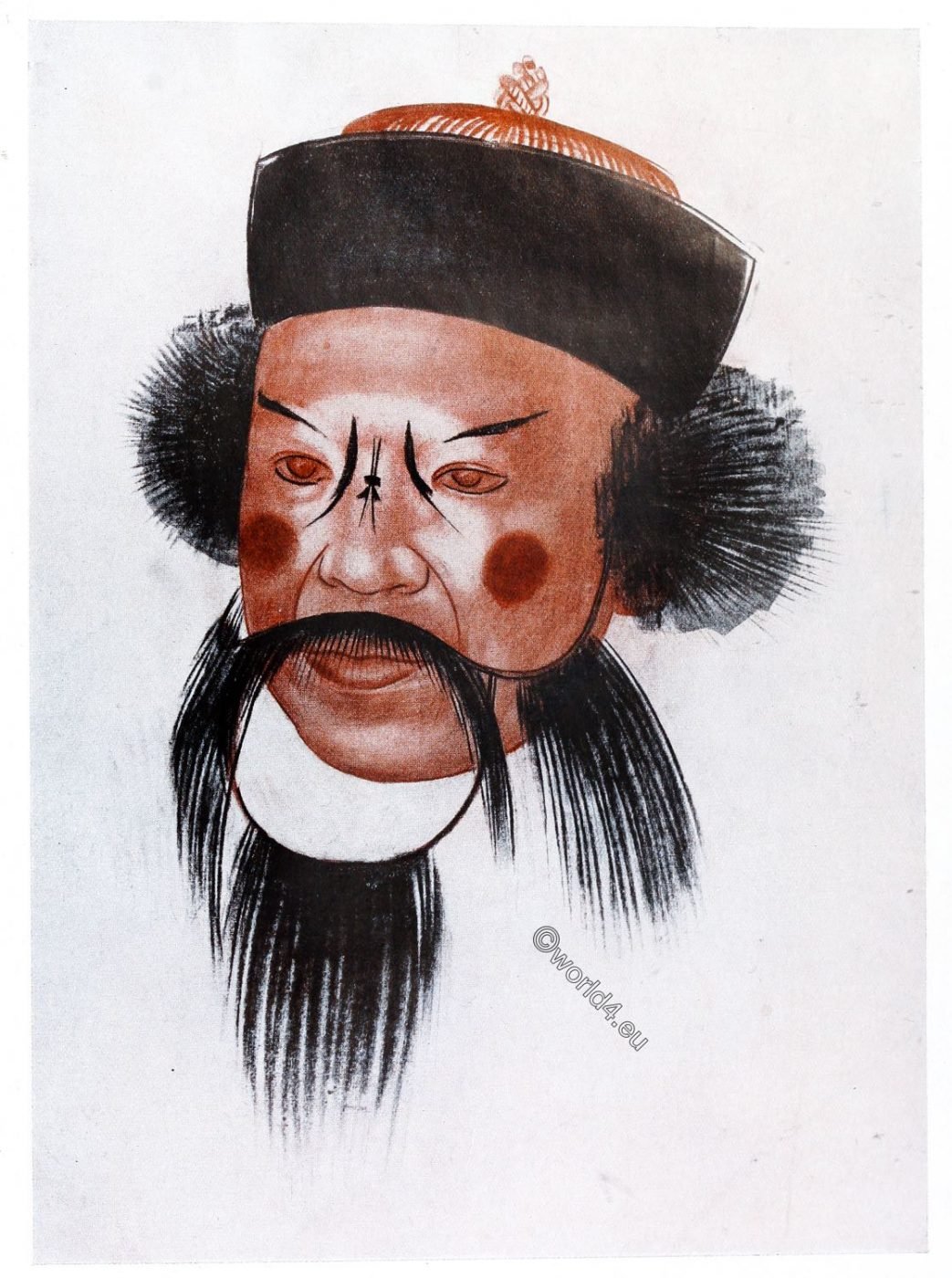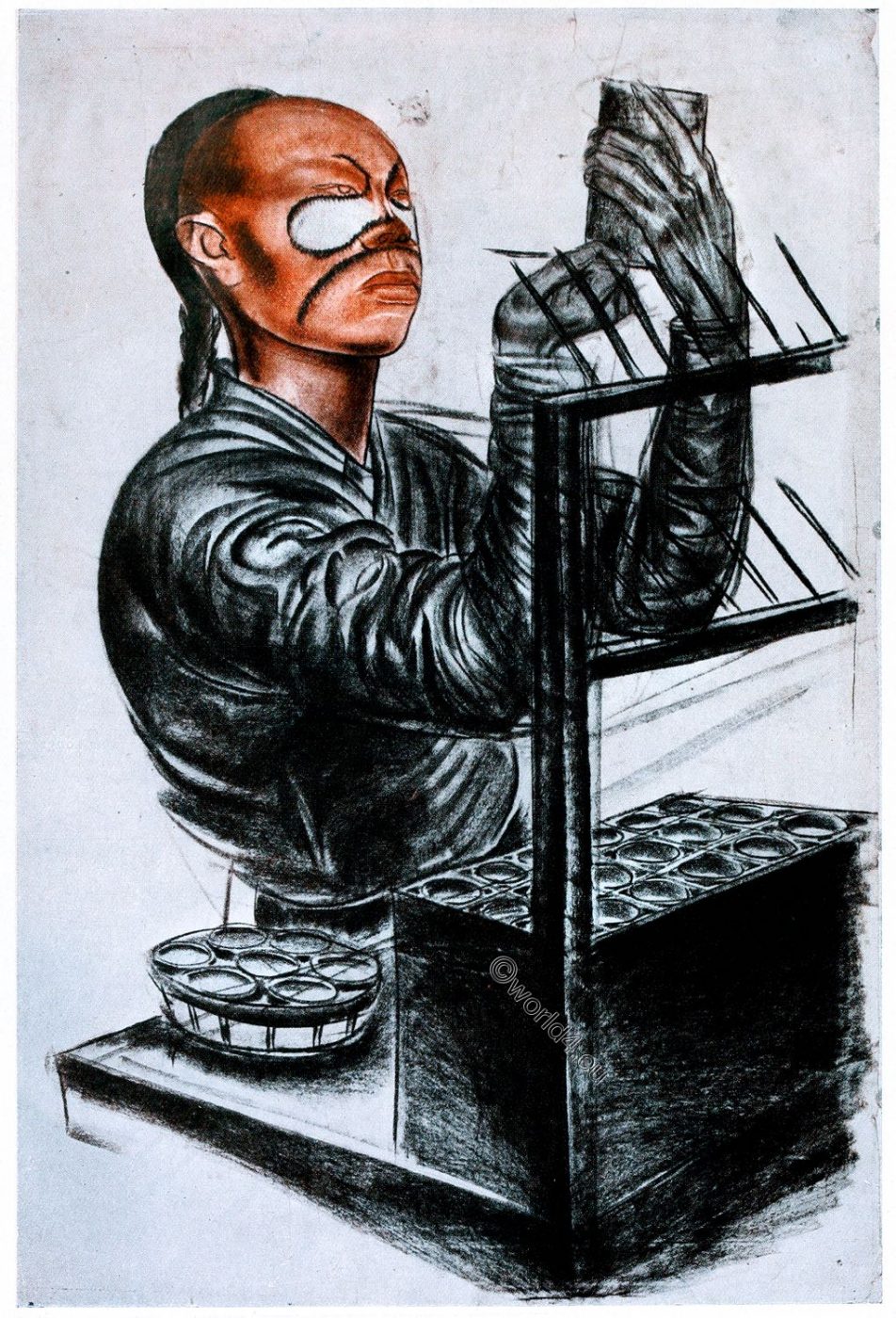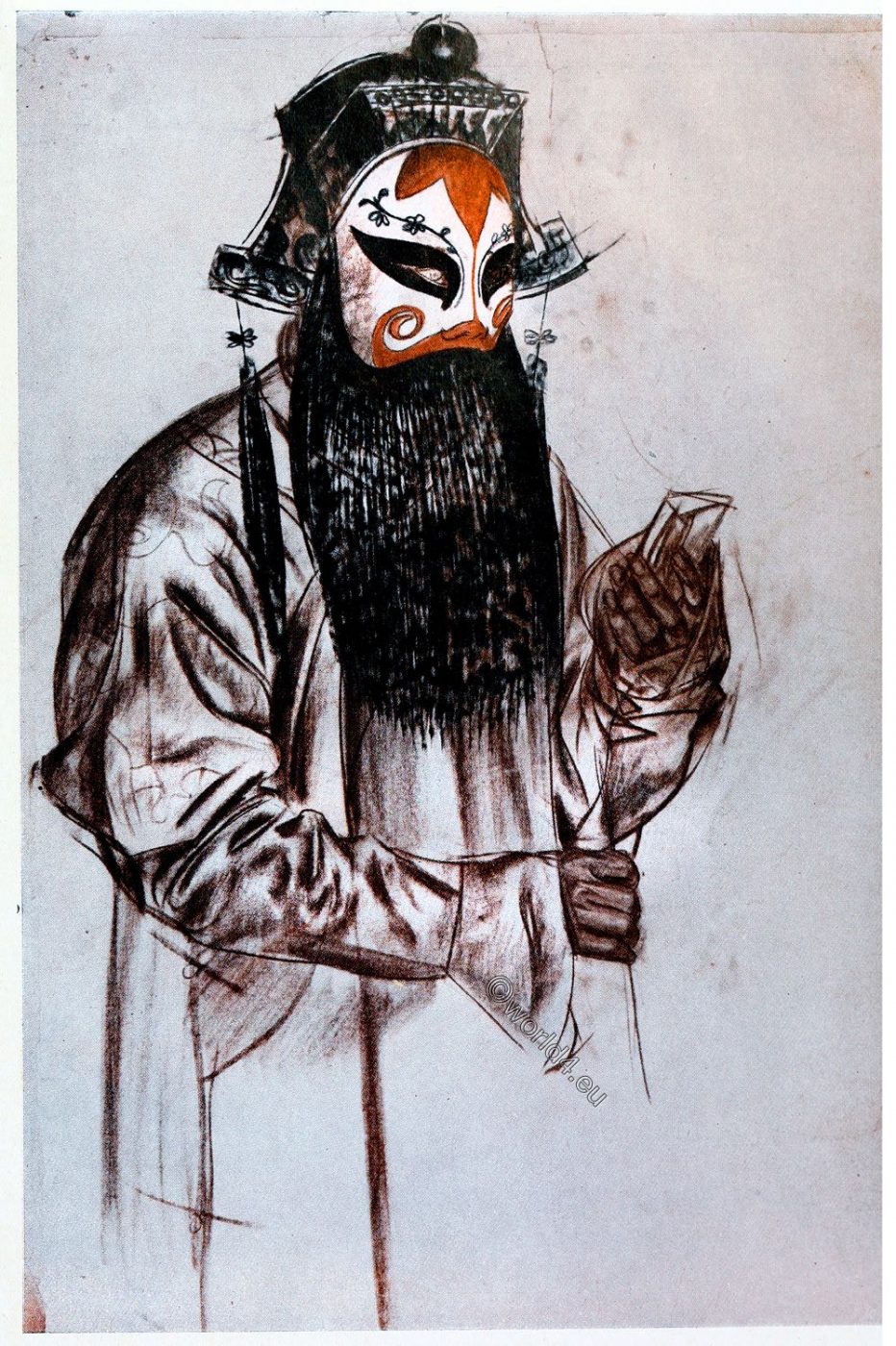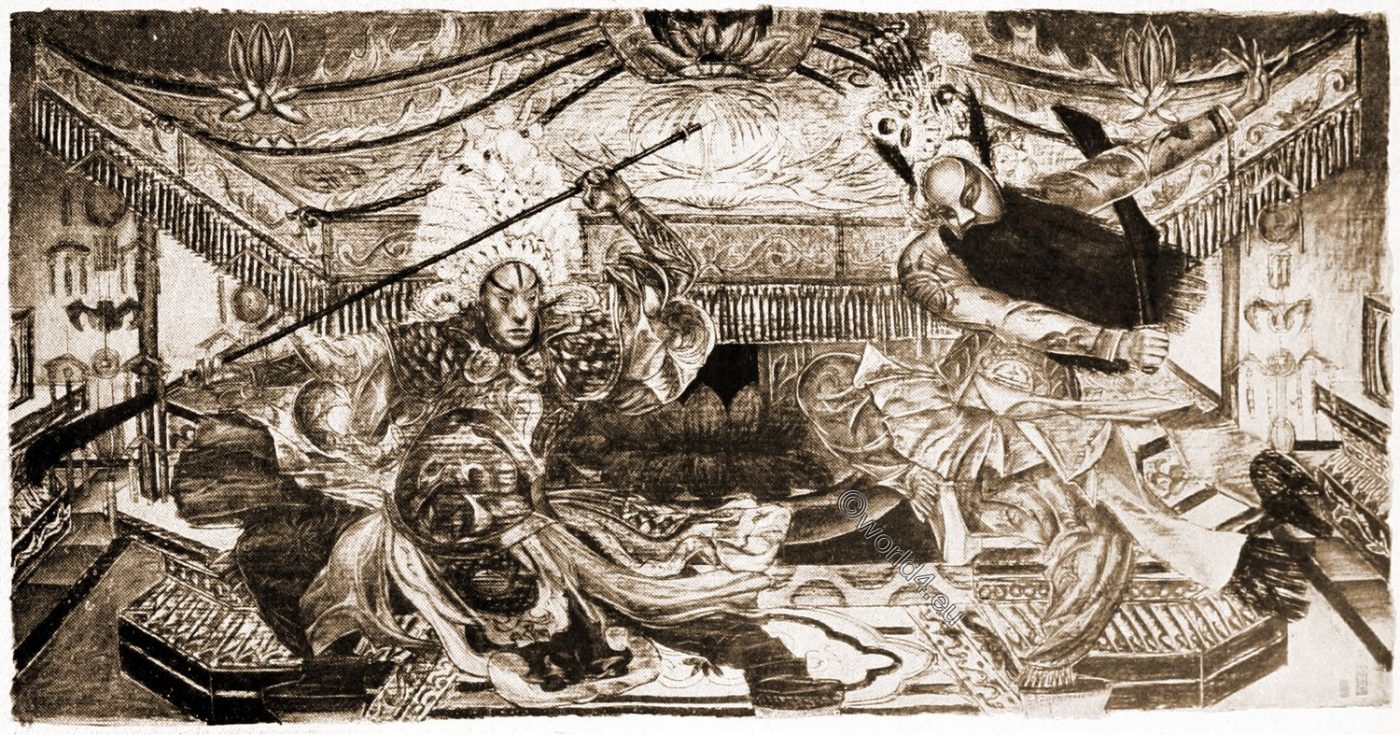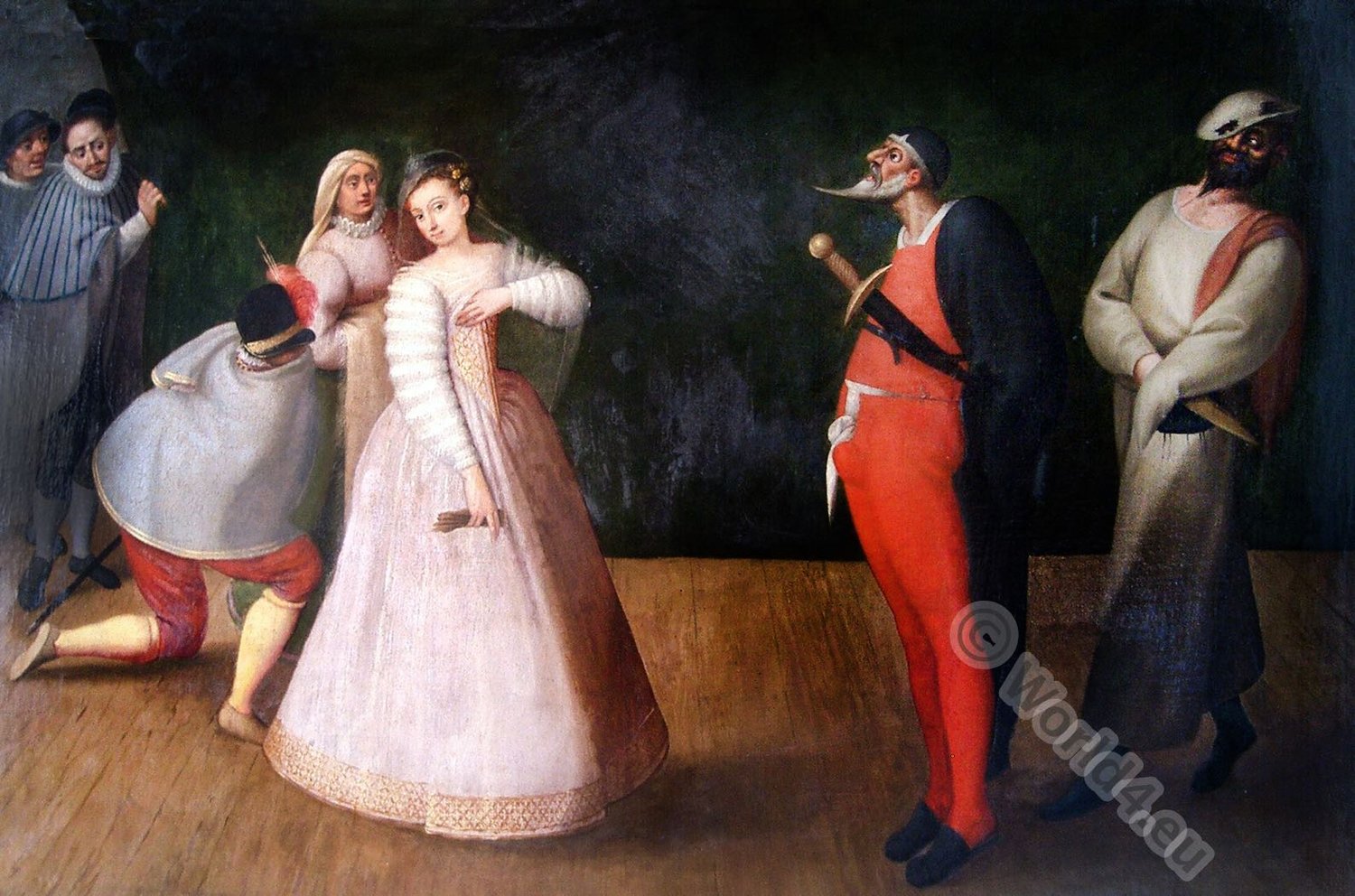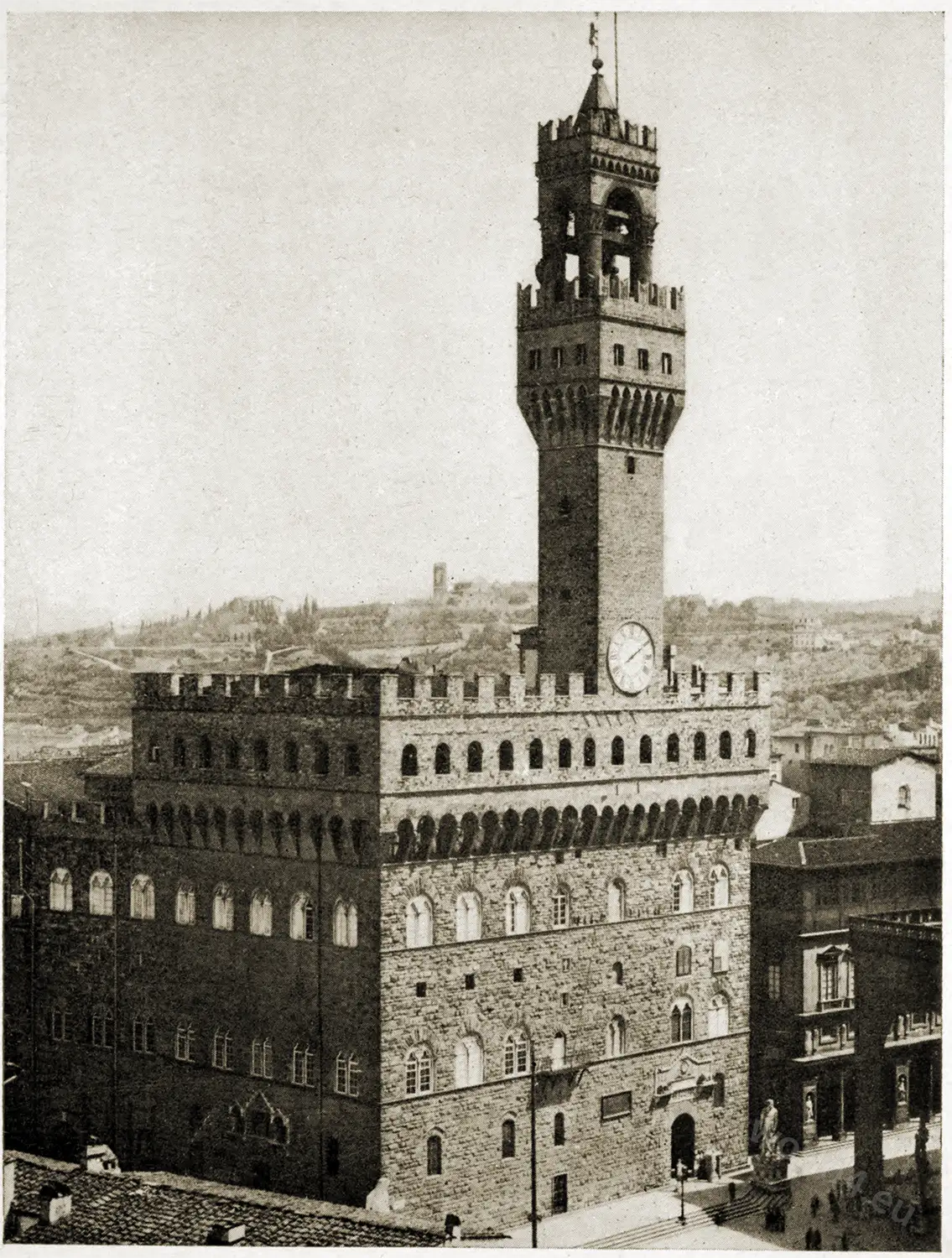THE CHINESE THEATRE BY CHU-CHIA-CHIEN. TRANSLATED FROM THE FRENCH BY JAMES A. GRAHAM. WITH ILLUSTRATIONS FROM PAINTINGS, SKETCHES AND CRAYON DRAWINGS BY ALEXANDRE JACOVLEFF. JOHN LANE THE BODLEY HEAD LIMITED LONDON MCMXXII.
Extended Edition (with enhanced images).
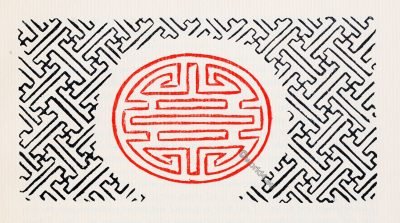
THE CHINESE THEATRE
PREFACE
IN the form of fugitive and passing impressions, of the plastic visions of a Westerner, guided only by the imagination and instinct: of a painter, I should like to express and to explain the attraction o] Chinese dramatic art and the importance which I attribute to it.
It was at Peking, whose countless walls one after the other reveal the phantoms and ancient mysteries of the autocratic East, where the profane hands of the traveller may touch the abandoned throne of the Celestials, that I entered into contact with modernized China and that I attempted to understand and comprehend the charm of her thousand year old culture.
In a hall of many-colored woodwork, where the grey mist of smoke struggled against the blinding rays of several huge ark lights, was first revealed to me dramatic art as it has been preserved in China, an art which is at once filled with simplicity and with wisdom.
Conventional and profoundly human, created by a people, this art has since assumed a definite jorm. The initiaiiue oj the individual is ruled by the noble traditions of past dynasties. We are transported back to the earliest times and see China as painted by Marco Polo, or as we divine her in the works of Confucius.
The scarlet beams of the monumental porch, a sort of miniature triumphal arch, the gay and brilliant mosaic of the posters, the lanterns ornamented by letters with living forms, the crowd, the tumult of ceaseless coming and going, all form a varied symphony of sound and colour. The sound of the tam-tam, the sound of hard wood beating the measure, guiding the orchestra and the movements of the actors, irritates the nerves and produces almost morbid sensations. At times the sharp voice of the little serpent skin violin or the shrill flute dominate all the other noises. The rhythm of this strange orchestra produces a visual impression of measure similar to that created by music.
Round about me are amber-colored heads whose tense expression reflects the action on the stage. I do not know what it is all about, nor do I know what the play signifies. I see movement and colour. I feel their surprising and perfect connection with the precise and complicated rhythm of those instruments which exasperate me. But I know they are absolutely indispensable, that they are appropriate to the action. They can only be applied to this particular form of action. Without them this action would lack the basis which is essential in order to give life to its fantastic expression.
But I hear another sound, expressive in its monotony, moving in its forced and over-shrill notes, perhaps even more artificial than any of the other instruments. It is the huma« voice. At first it sounds monstrous to our western ears. Yet it is strangely beautiful when once one accepts it as such. l1t the ensemble of action it acquires the value of a musical instrument. It weaves a cadenced ornament, sometimes following the measure of the orchestra and the varied forms of movement, sometimes in direct opposition to them.
A jade green sky, splashed with yellow along the horizon, and the pure fresh air of a Peking October morning. I near the point where the walls of the Temple of Heaven and the Great Wall form a passage almost a mile long. I hear a bizarre chant, a wild and mystic melody. Their faces turned toward the vast wall, a dozen or so boys are practicing, under the supervision of an old man with the head of a eunuch. They are pupils of a theatrical establishment with their old professor.
A room which appears larger than it actually is, owing to the uncertain light of a few small electric lamps looking yellow in the warm, damp atmosphere with its heavy and perfumed vapors. Actors, dressers, patrons of the stage, casual visitors, form a little world apart. Sumptuous robes are hanging on pegs together with banners and lances. On shelves are hats, helmets, crowns, silk pompoms, pheasants plumes, gilded and shining ornaments. They look like rows of fantastic flowers on the shelves of a hot-house.
In front of frames bristling with some forty paintbrushes – one for each colour – stand rows of pots of greasepaint on cast-iron heaters. The bright, intense colors of this pallet are not appropriate to character make-up. They are intended to produce the completely conventional mask which suppresses in the actor all personal element. The smell of tallow mingles with the smell of perspiration. The actors are making up. The agility of those yellow, emaciated fingers is marvelous. In one hand is a small mirror. The other holds, Chinese fashion, a paintbrush which moves over the face with rapidity and precision, laying out on the smooth and beardless surface colors separated one from the other with pure and primitive clearness.
The painted mask reminds one of those seen on ancient pictures and popular engravings. It is a real mask in which only the eyes live with an exaggerated life. But they squint and dance rather than mimic. Sometimes, when not moving, they recall inlaid quartz or agate. This, together with the rest of the sumptuous paraphernalia, evokes certain gods of the Taoist temples. Often the mouth, the most mobile part of the face, is entirely hidden by a thick, silky beard. But even without the beard the ornamentation of the painted mask is so precise and conventional that the mouth takes no part in the play of expression. That is why the Chinese theatre – although actual masks are very rarely used- is the theatre of masks and of characters created and defined by ancient traditions. It is this which brings it so near the antique theatre, the mystery plays, the Commedia dell’arte, so near to all forms of theatrical art which are not the expression of individual personality, but the reflection of a race. It is art which thus serves to express the moral traits of a people.
The choice of the conventions necessary to the action is comparatively restricted.
The limited means of which the actor disposes has naturally led him to simplify and intensify his art to a high degree. But for this very reason he arrives at the most perfect form from the technical point of view. How often have I not observed the sober and graceful manner with which an actor opens a non-existing door and steps into an imaginary shadow. His supple and precise movement finds complete expression in the logic of rhythm, that basis of all plastic art.
The tam-tam beats its crazy measure. The sound of the trumpets, gongs, and drums transports you to the field of battle. Here comes the warrior. A shining, golden insect, resplendent with bright colors, brutal in their harmony, but always logical. He comes on with the tiger’s step, a traditional motion, proud and aggressive. On reaching the front of the stage the movement becomes wilder and recalls the image of the peacock displaying the glory of its plumes. One feels that the actor has the desire to regulate his movements in harmony with all his surroundings, His gestures and the composition of his attitudes produce pure and voluntary arabesques. He is guided by a geometrical formula.
The principal lines of the square are very distinct, the horizontals and verticals are opposed to the diagonals. There is nothing confused or hesitating. Combats and rapid movements are under absolute control. Suddenly everything is transformed into a statuesque vision. Yet it is not a gesture arrested in full expression. Rather is it the static stylization of action. But it does not give one the idea of a lifeless pose. Sometimes a hand, sometimes a finger, sometimes the mere movement of the eyes gives you the dramatic sense of the action.
But all is ruled by the perfect laws of rhythm. The expression of the gestures, the opposition of the movements, the sense of their dynamic value produce an impression only possible through the medium of an art which, by the accumulation of century old traditions, has become a perfect craft.
Alexandre JACOVLEFF.
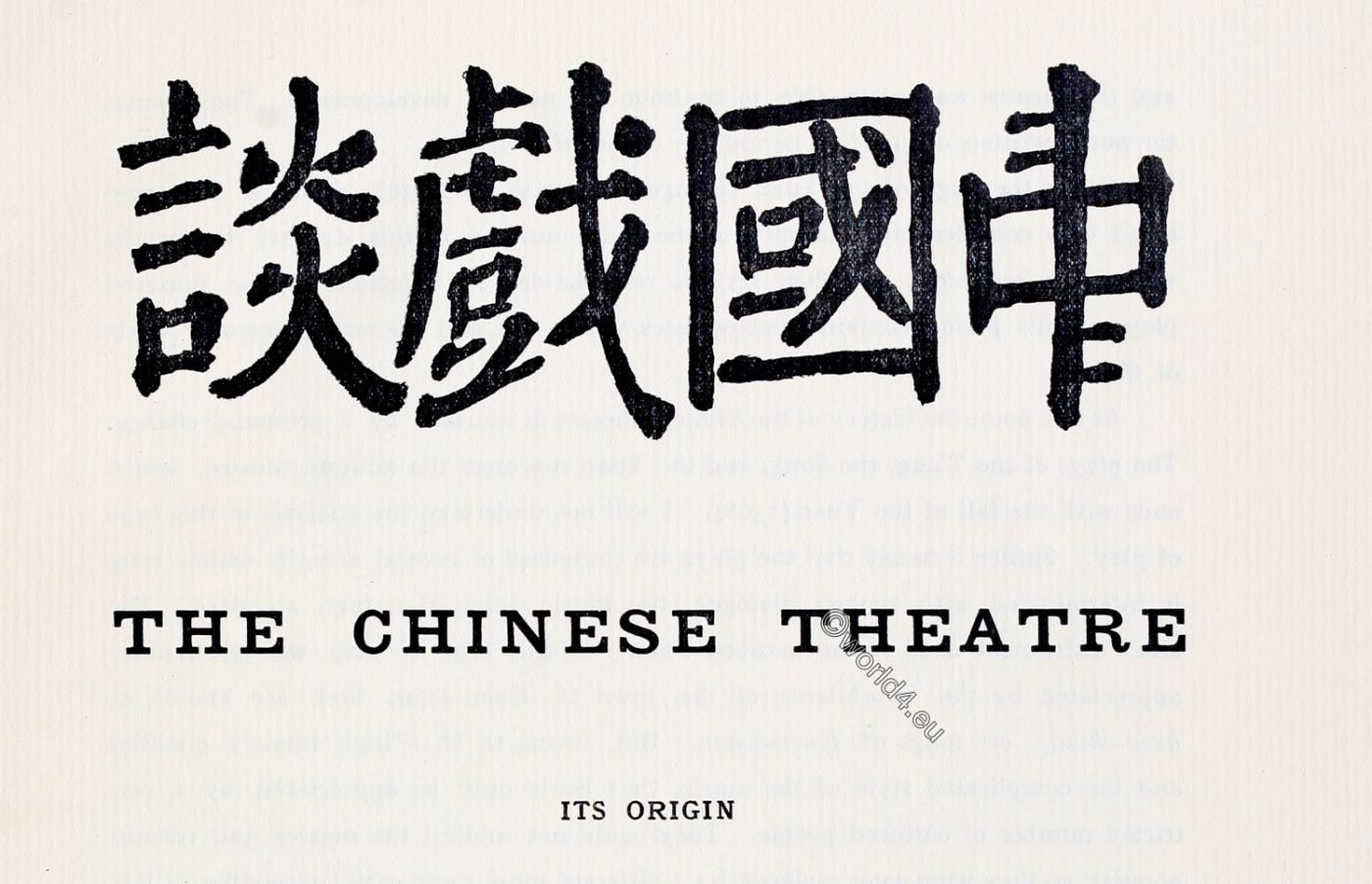
THE CHINESE THEATRE
ITS ORIGIN
HISTORY does not actually tell us when the drama was born in China. All we know is that the Emperor Ming-Huang, of the Tang Dynasty, who reigned from the year 712 to the year 755 of the Christian era, employed a company of 300 comedians which he directed and supervised himself in the” Garden of Pear-trees”. Chinese historians agree that the earliest plays, known by the marne of chuan-chi, date from this epoch.
But history does give us a certain amount of more precise information. During the later Tang Dynasty the Emperor Chuang-tsong, who only reigned three years (923-926), was thoroughly familiar both with music and the stage. He “made-up” and disguised himself, and acted in person amongst his comedians in his private residence. His love of the stage cost this ruler first his prestige and then his life – one of his favorite actors stabbing him to death.
Owing to political upheavals, dramatic art then suffered an eclipse lasting half a century up to the beginning of the Song period. The Song Dynasty, which ruled for three centuries, brought a return to the old traditions in all branches of art, and the theatre was again able to continue its normal development. The dramatic works written during this period are called hi-k’iu.
Under the reign of the Yuan (Mongol Dynasty, 1280-1368) dramatic art developed very considerably. In spite of the short duration of this dynasty the works written are numerous and their style is remarkable. A collection of one hundred plays of this period contains masterpieces which are still played in certain parts of China.
At this point the history of the Chinese theatre is marked by a profound change. The plays of the Tang, the Song, and the Yuan represent the antique theatre, which ends with the fall of the Yuan (1368). I will not undertake the analysis of this type of play. Suffice it to say that the plays are composed of several acts, in which song is intermingled with spoken dialogue, the music being of a high standard. The chief instrument used is the bamboo flute. As this type of play was particularly appreciated by the inhabitants of the town of Kuen-shan, they are known as kuen-chiang, or songs of Kuen-schan. But, owing to their high literary qualities and the complicated style of the music, they could only be appreciated by a restricted number of cultured people. They could not interest the masses and remain popular, so they were soon replaced by a different kind, more easily accessible to less cultured audiences. Today there remains only one theatre in China which still produces kuen-chiang.
The necessity of amusing a wider public resulted, with the advent of the Ming Dynasty (1368-1644), in the birth of a new type of play, the huei-diau. It was first seen at Huei-cheou, the town from which the imperial family came. From this time onwards plays became very short, generally of one act, not at all literary, and accompanied by noisy music. The huei-diau were at first very popular and remained so until the day when, under the reign of the Manchu (1644-1912) they were replaced by the songs of Peking, or king-diau. From the start the king-diau were adopted by nearly all theaters throughout the country.
Nevertheless, owing to ever closer intercourse with Westerners, the Chinese theatre did not remain entirely free from European influence, as is seen from the wen-ming-hi, or “theatre of civilization”. This is a sort of comedy on the European model composed entirely of spoken dialogue and without the accompaniment of any orchestra.
This new type of play is still in an undeveloped state and has not yet taken root very firmly. Only the future can tell whether it will gain a footing and become as widespread as the other style. For the time being it may be said that the only drama which has any vogue in China is the king-diau, And we shall here only deal with the latter.
THE THEATERS
Public theaters are found almost everywhere in China. In the large cities like Peking, Shanghai, etc., they number from four to six. Their architecture is very simple, and, apart from certain ornaments of the facade, there is nothing special about it. All truly Chinese theaters look alike. One might well believe they have all been built according to one plan, differing only in size.
The principal entrance to the Chinese theatre is a large double door. This is surmounted by a triumphal arch of wood, painted red and white, with the name of the theatre inscribed in gold in the centre. The inscription is lit up at night by electric lights. One or two more up-to-date theaters use luminous signs. To the right and left of the doorway are large red posters with black lettering, giving the program of the evening and of the following days.
After passing through a vestibule, one enters through a second door into a spacious hall. It is almost square and holds from seven to eight hundred spectators. The stage is at the end of the hall facing the entrance. It is almost square and about six feet high. At each side is a red column covered with poetry in gilded letters. The columns are some thirty feet high supporting a kind of dais which completely roofs in the stage. Its three sides are covered with wood sculptures.
The stage itself is railed in with a red and gold wooden balustrade. At the back are two doors, one on each side. They are closed by silk curtains, heavily embroidered and covered with small, highly polished mirrors. Tradition wills that the actors come on through the righthand door and go off through the left.
The whole wall forming the back of the stage is covered with silk and embroidery and small mirrors. The stage itself is carpeted and filled with tables, chairs, stools, cushions. The arrangement is of course altered to suit the different acts, the changes being made before the eyes of the audience, for in the Chinese theatre the curtain is unknown.
The roof of the theatre is flat, with a raised centre containing windows which give sufficient light in the day time.
Galleries run round the sides, the first tier containing boxes holding from eight to ten people. These are the best seats in the house. The ground-floor lateral galleries contain benches on which the poorest spectators sit.
The gallery over the entrance is also divided up into boxes, and communicates with the lateral galleries on the corresponding tier. Two wooden staircases, one on each side of the door, lead to these boxes. The space between the door and the stage, known as the cheu-dze, contains tables, chairs and benches.
At night the theatre used to be lit by oil lamps, but for the last fifteen years gas or electricity have been used instead, at least in the larger theatres. The only thing which is still unknown is the use of limelights or spotlights.
THE DOUBLE ROLE OF THE THEATRE
In the eyes of the Chinese the theatre is not merely a place of amusement, but a place where the ignorant receive moral instruction, and it thus fills two roles at once. It is not ruled by much ceremony, and the public has an amount of freedom unknown in the European theatre. The audience smokes, drinks tea, eats cakes and fruit, or even partakes of meals during the play.
But being a place of moral uplifting, the theatre is expected to stimulate virtuous sentiments by picturing on the stage great historic acts of bravery and patriotism. It must condemn vice by showing the punishment of traitors, evildoers, the ungrateful, wives who are untrue, etc. It must criticize the ridiculous habits of society in satirical plays. In order to give European readers an idea of what is expected we will summarize two plays which are both well known in China.

I. – The father who abandons his son in order to save his nephew.
During the invasion of a Chinese province by barbarians, Ts’ouei was obliged to flee hastily from his village with his wife, his son, and his nephew, whose father was dead and whose mother was away.
As the children were very young and unable to run, Ts’ouei had to carry them in turn, his wife being too weak to lift either.
In spite of all his efforts the party advanced but slowly, for each time one of the children was put down it refused to walk, crying bitterly. What was to be done? At any moment the enemy might arrive. In order to escape it was essential to come to a quick decision.
And Ts’ouei, in his generosity, conceived the plan of making a great sacrifice to the memory of his dead brother. He said to his wife: “We must leave our boy behind, for my brother had no other child than our nephew to continue in his family the gifts to his ancestors, and we must save him. And mayhap our son will be saved by some passer-by. In case he is killed, be consoled, oh my wife. We are young enough for heaven to bless us with another child.” And the mother with bleeding heart consented to this great sacrifice.
On the roadside was an orchard of mulberry trees. The father decided to tie his son to a branch, in order that he might eat some berries were he not immediately found by passers-by.
Ts’ouei made his son climb onto one of the branches of a tree to pick some berries and then tied him tightly to it with his belt. Then he tore a piece of silk from his garment and, biting his finger, wrote a few words upon it with the blood and fastened it to the child’s dress.
In the distance could already be heard the triumphant cries of the invaders. No time was to be lost. The father was sad, the mother bathed in tears, while the son cried aloud on the tree. But when Ts’ouei wanted to pick up his nephew, the little boy threw himself on the ground and refused to leave his cousin. Ts’ouei and his wife had to use force to take him away.
Chance made Ts’ouei’s sister-in-law, mother of the child that had been saved, choose that very road to flee before the invaders. Passing by the orchard she heard the cries of the child. She entered and saved her nephew.
The invasion was soon repelled and the two Ts’ouei families had the great joy of being safely reunited.
II. – The punishment of an unfaithful woman.
This play deals with the life of Chu Mai-cheng, a man of letters well known in Chinese history. Before achieving fame he was so poor that he had to cut wood to make a living, without, however, interrupting his studies. His wife, an ambitious woman, and incapable of sharing this miserable life, repeatedly expressed the desire to leave him.
At first the husband dissuaded her, saying that he would not always be poor, that his qualities as a writer could not remain long unrecognized and that he hoped to obtain a public post at the next competition.
Nevertheless the wife was resolved to go, and despite all the efforts of the husband, who told her how hard the parting would be for him, she left without any regret. She became the wife of a trader of the district with whom she was no happier, for her new husband treated her with scant kindness.
Shortly afterwards Chu Mai-cheng went to the capital to compete for an official post. He passed the examination so brilliantly that the Emperor appointed him governor of his native town. So he returned there in a magistrate’s chariot, surrounded by servants. His ex-wife hearing of this came and threw herself down before his chariot, asking his pardon and that he should take her back.
The magistrate with great calm spoke to her as follows: “You left me because I was poor, now you come back because I am no longer so. Do you not know that a wife who has abandoned her husband is like water spilled in the dust?”
And ordering a retainer to bring a bowl of water, he spilled it on the ground, saying: “I will take you back when you can put that water back in the bowl”.
The woman, bowed down with shame and regret, went away and killed herself shortly afterwards.
ACTORS AND ACTRESSES.
In China there is no school which teaches singing, elocution and music. Actors are trained by an old comedian or by the director of a troupe of comedians.
Young men who choose the theatre as a profession are usually poor and of humble origin. They have to submit to severe discipline from their master.
Apprenticeship consists in learning a certain number of parts by heart or of reciting, singing, acrobatic tricks, swordsmanship, and it lasts from four to six years.
As their master has during this period to pay for their keep, it is only just that his pupils should afterwards work for him for nothing during a corresponding number of years. After paying this debt, they are free to go where they will.
From the social point of view comedians are utterly despised. This is because of their humble origin, which places them outside the ranks of society. It is rather their birth which is the cause of this than the fact that they act on the stage, otherwise it would hardly be conceivable that the ancient emperors should have taken such close interest in actors.
With regard to actresses we learn from Chinese history that while women acted on the stage under the reign of the Mongol emperors, their appearance was forbidden after the Emperor K’ien-long took one for concubine. From then onwards to 1900, the Chinese stage was deprived of actresses, female parts being played by youths.
One exception to this rule must, however, be mentioned.
About forty years ago a company composed solely of women was formed at Shanghai and played in a theatre called the Mau-eul-hi or ” theatre of cats”, which still exists today. But in this theatre all the male parts are played by women, and it was only in 1900 that actors and actresses were again allowed to appear together on the same stage.
Actresses are by no means, however, employed universally, many theaters preferring to do without them. And at the present day three distinct types are to be found of what is known as the Pekingese theatre, namely those consisting of actors only, those consisting of actresses only, and those consisting of mixed troupes.
ORCHESTRA AND MUSIC
The orchestra is essential to the Chinese theatre, as all plays are accompanied by music. It is composed of from eight to ten musicians, and the principal instruments are two-stringed violins, drum, tam-tams, “pan-kou” (a kind of drum with a very sharp tone), clarinet, castanets, cymbals, flute, guitar, mandolins, “hiendze” (a long three-stringed mandolin covered with serpent-skin) and “pangdze” (a piece of hollow wood which is beaten with a stick).
Naturally these instruments are not all used simultaneously – the brass instruments, drums and pan-kou accompany military scenes of violent action, while the instruments with chords accompany songs, and so forth.
The bandmaster himself plays on the pan-kou and uses the castanets. It is he who marks the time.
But it is the violinist who is the most important of all the musicians, for it is he who accompanies the songs.
The instrument mentioned last on the list given above, the pang-dze, is only used when the actor on the stage is singing in pang-dze, a style of song originating in the province of Shen-si which was introduced into the so-called “king-diau” theaters some thirty years ago. One must therefore not be surprised to hear both kinds of song on the same stage, or even to hear the same piece sung in both styles.
This does not in any way change the play, for it does not entail any alteration to the scenery or to the characters depicted in the scenes.
It may, however, be noted that the “king-dian” or Peking style is more suitable to male parts, while the music of Shen-si, which is slow and languid, is better suited to female parts.
WINGS – GREENROOM – DISCIPLINE – SUPERSTITIONS
The wings and greenroom of a Chinese theatre are only separated from the stage by a thin wall and the public is strictly forbidden to visit this part of the building without a special permit.
The stage door leads straight into the large greenroom, which is filled with tables, boxes, wooden swords and spears, flags and other “props”. The Walls are covered with masks, wigs, false beards, hats and costumes of different patterns and periods.
In the centre of the room, near the windows, is a large table covered with boxes of greasepaint, mirrors and paintbrushes. It is here that the actors make up.
During the show this room is a busy place. All the actors are united here. Some, fully dressed, stand ready to go on; or walk backwards and for wards patiently awaiting their turn. Others who have finished for the evening come off, remove their make-up and undress. Others again are making up for female parts, or are painting their faces as warriors or traitors, or for comic parts.
Nothing can be more fascinating than to watch the proceedings. First one sees faces only half painted, figures from mythology dressed in everyday clothes, extraordinary beings with women’s heads and hair, but dressed as men.
Gradually the faces disappear under coats of paint, and the original sex is completely disguised.
Here, where the whole company gathers together, the actors are subjected to a very severe discipline.
Each one has his seat, consisting of a large, painted, wooden box in which he keeps his belongings. Only the comedians, who enjoy certain privileges, are allowed to jest. And an actor playing the female part of a woman of light morals cannot sit down on anyone else’s seat without hearing some very rude language, for this is considered extremely unlucky by the victim, who is convinced that it will result for him in a number of dire catastrophes.
Chinese actors are highly superstitious, as is shown by the following custom. Up against the wall which separates the wings from the stage stands an object which is never shown to the public. It is a wooden statue having the appearance of a child. Every day it receives offerings consisting of perfumes, and never does an actor go on without first doing homage to it.
This idol, commonly known as Lang-lang-pao-sa, is venerated by Chinese actors as the divinity protecting their corporation. But in spite of its popularity and influence amongst actors, its history and origin remain obscure. Some authorities ha ve it that it is nothing but the figure of the Emperor Chuang-tsong (who was murdered by an actor). During his lifetime he was always a patron of the stage, and the actors deified him in gratitude.
THE SHOWS
In all Chinese theatres two shows are given daily, one in the afternoon and one in the evening.
Each show consists of a different program and each program includes a series of little plays of varied character. This enables patrons to return to the same theatre very frequently.
In theatres of the Peking school the plays are always preceded by a pantomime scene called T’iao-chia-kuan, meaning Dance of Chia-huan.
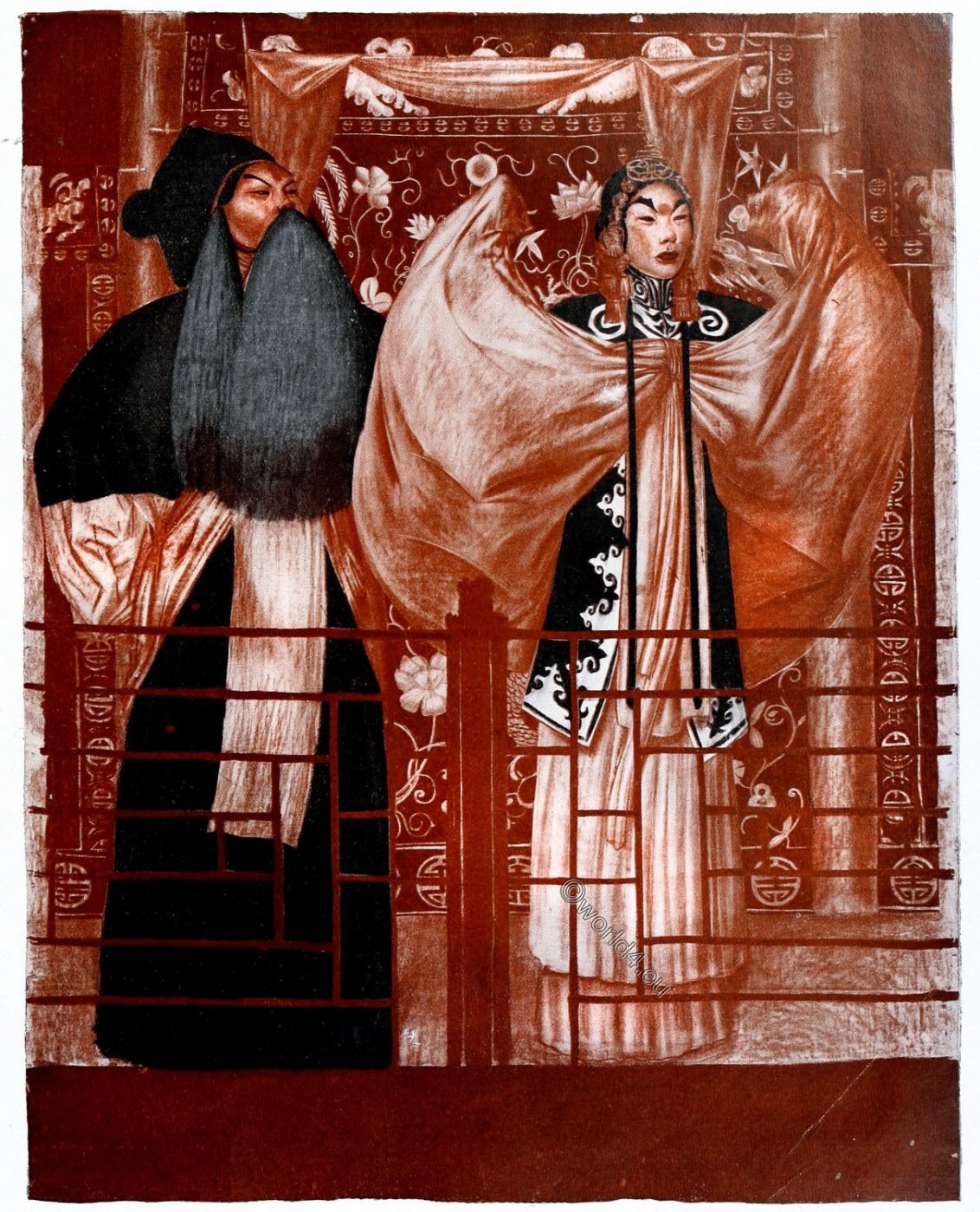
In this scene the mimic, wearing a white mask and dressed as an antique dignitary, first executes a dance to the accompaniment of music and then, by gestures, bids welcome to the audience. This scene, being traditional, does not figure on the program.
The first play on the program is rarely of interest and usually consists of a short curtain-raiser. The real entertainment only begins with the second piece.
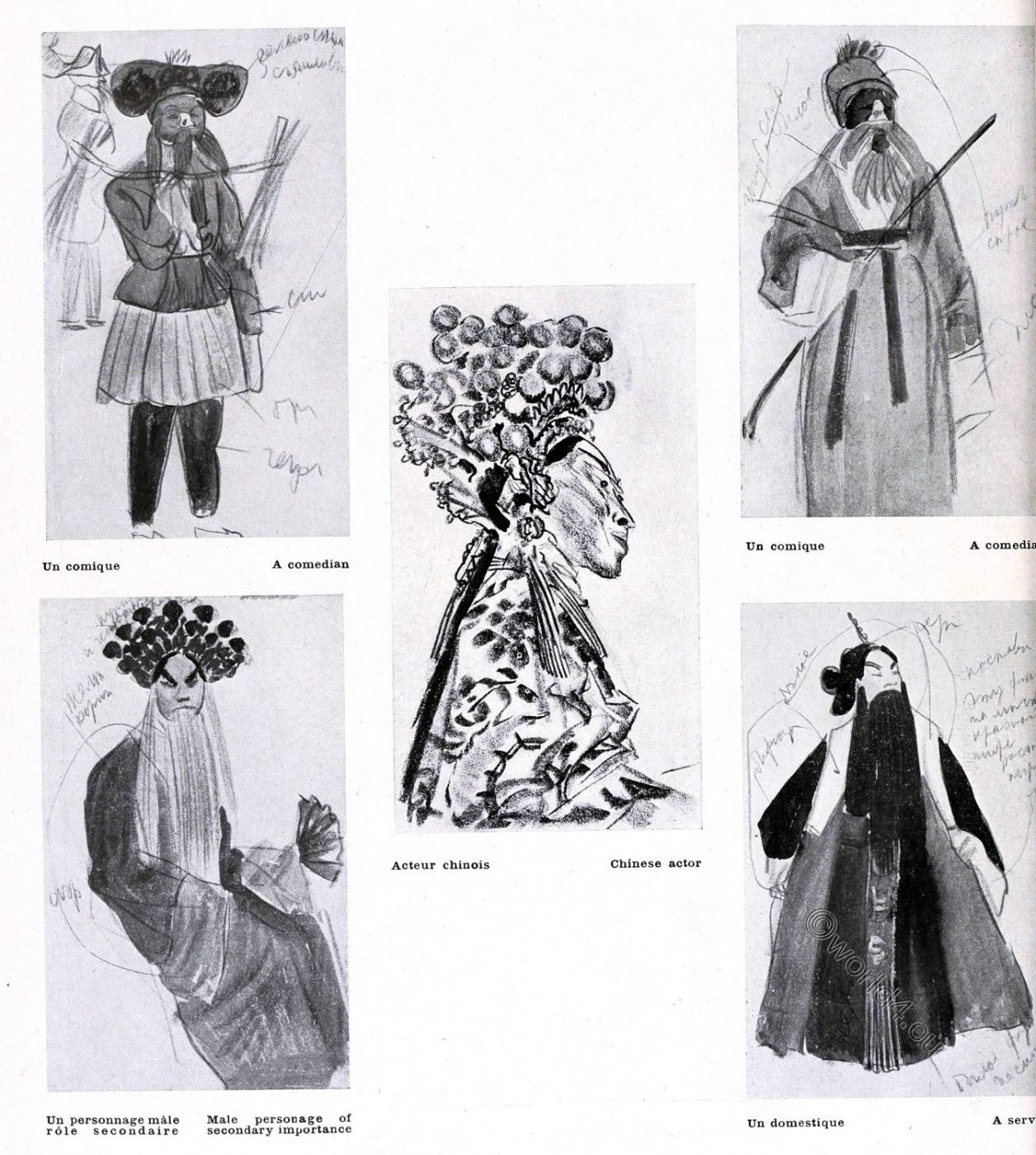
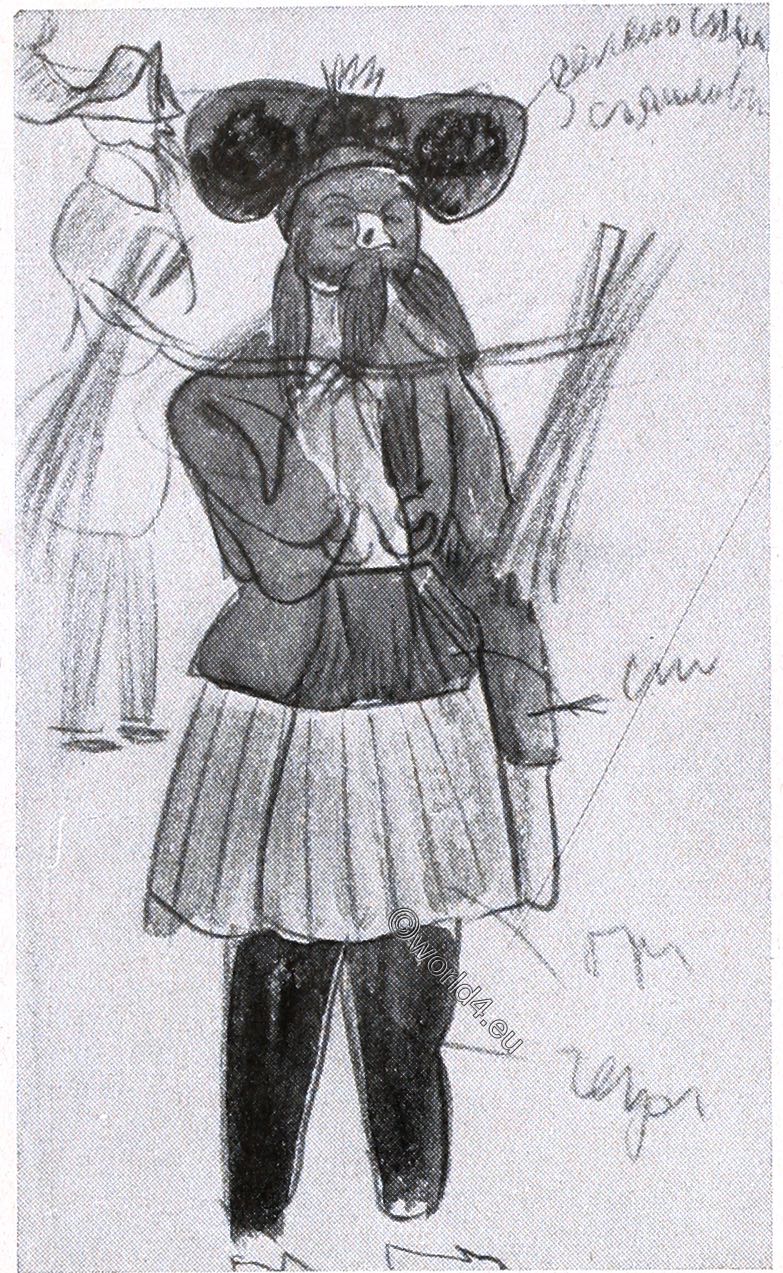
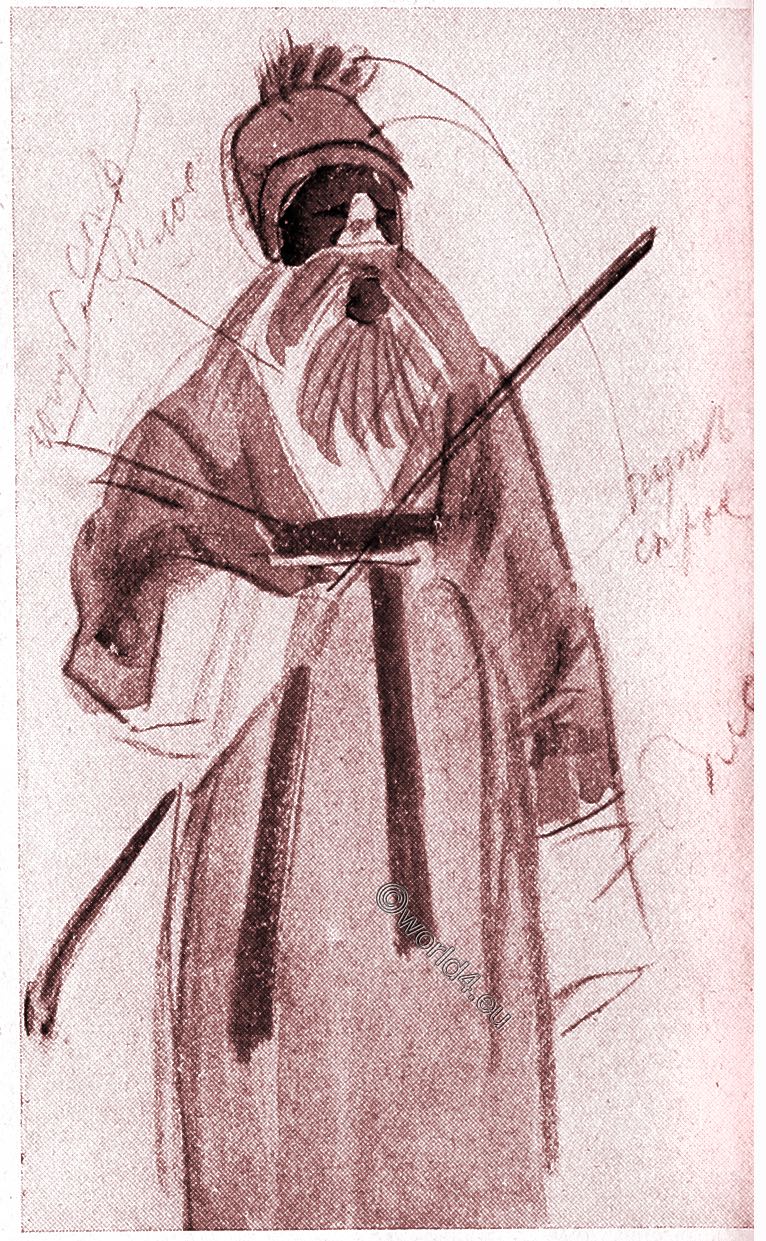
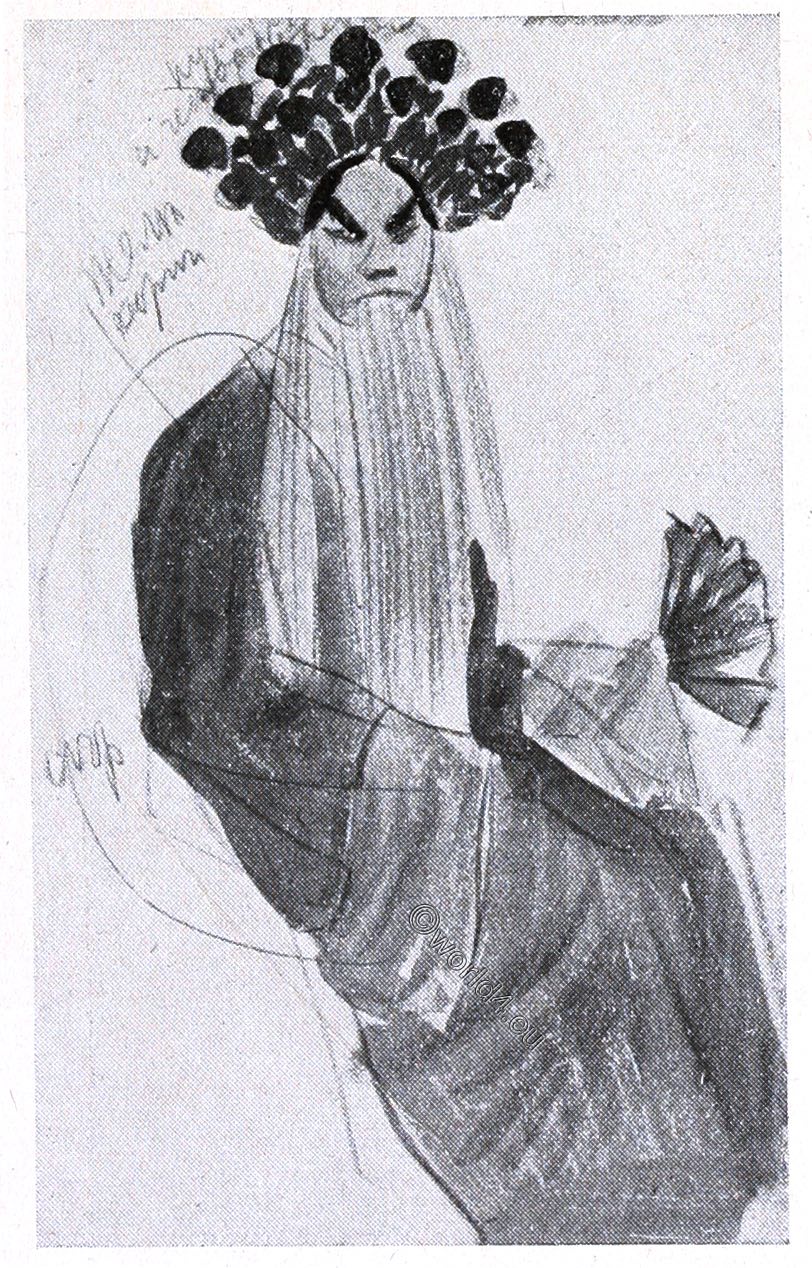
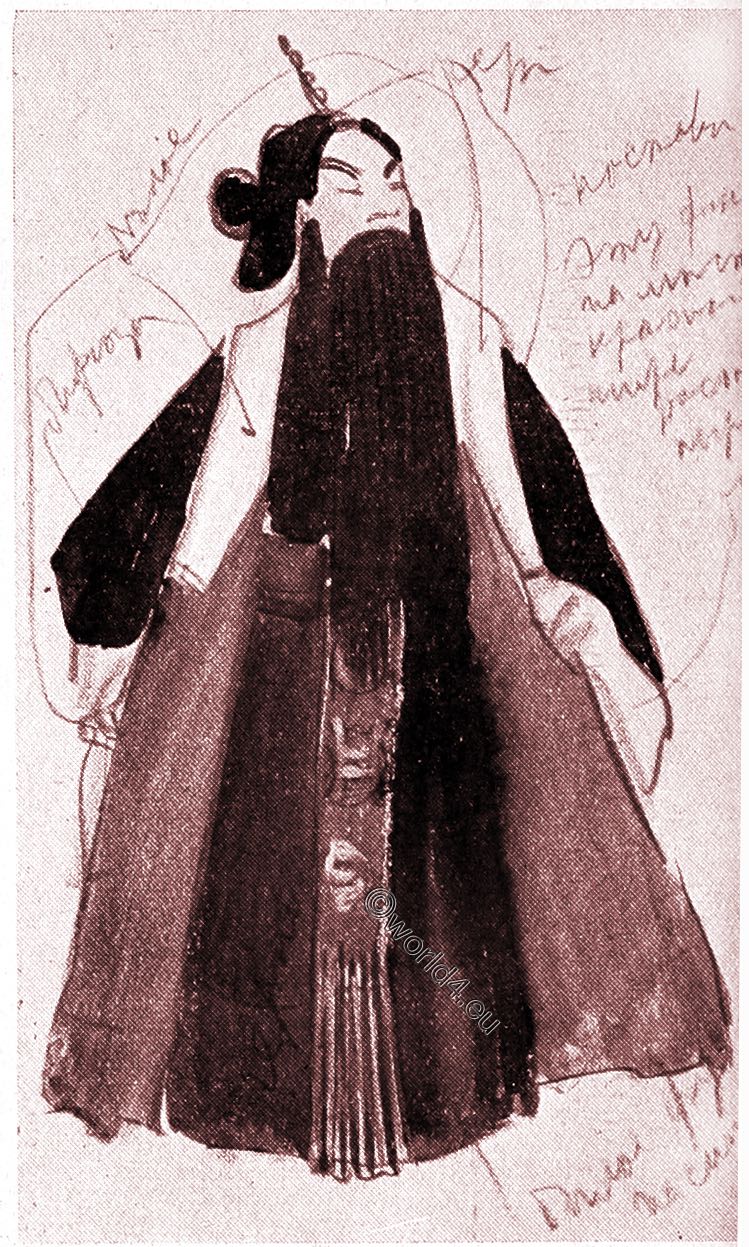
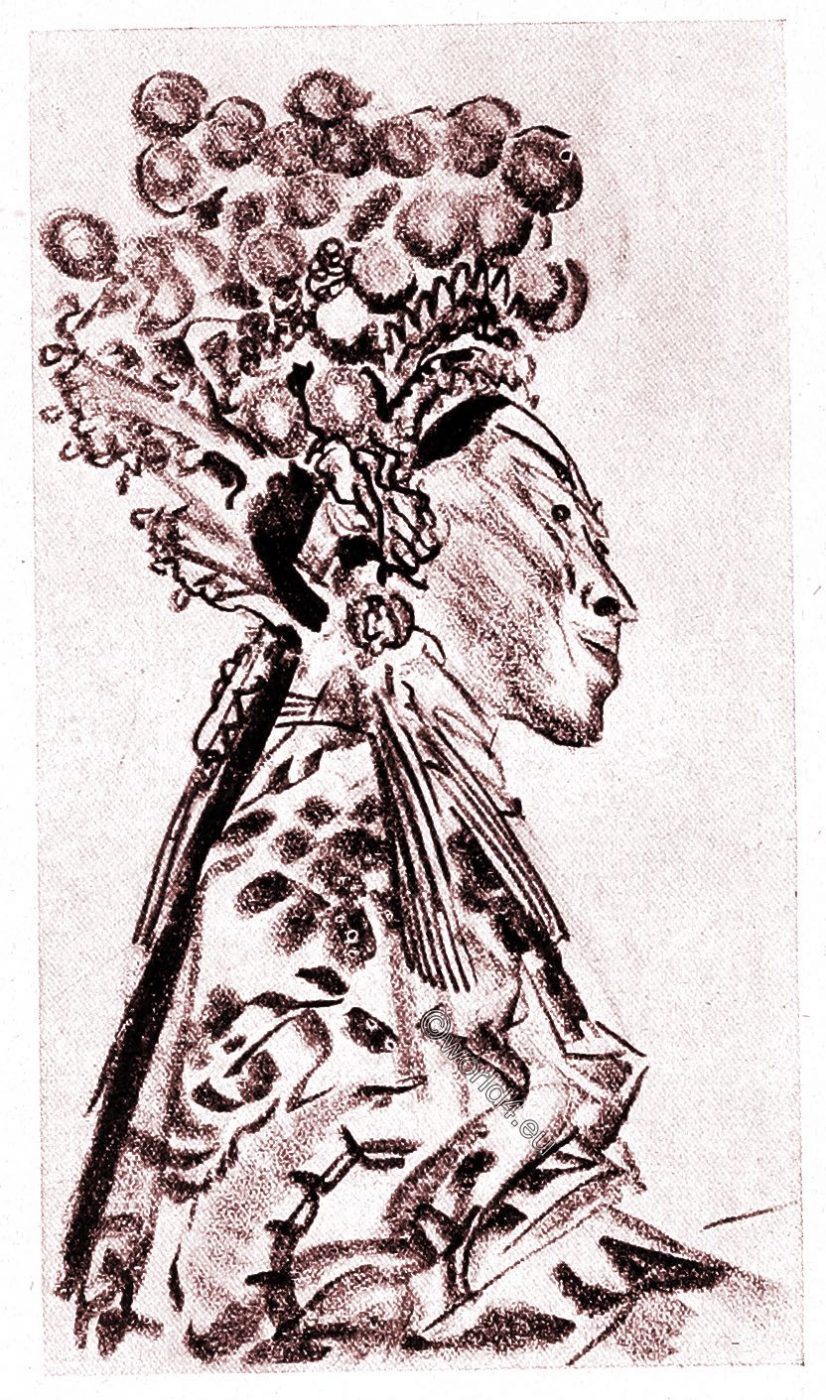
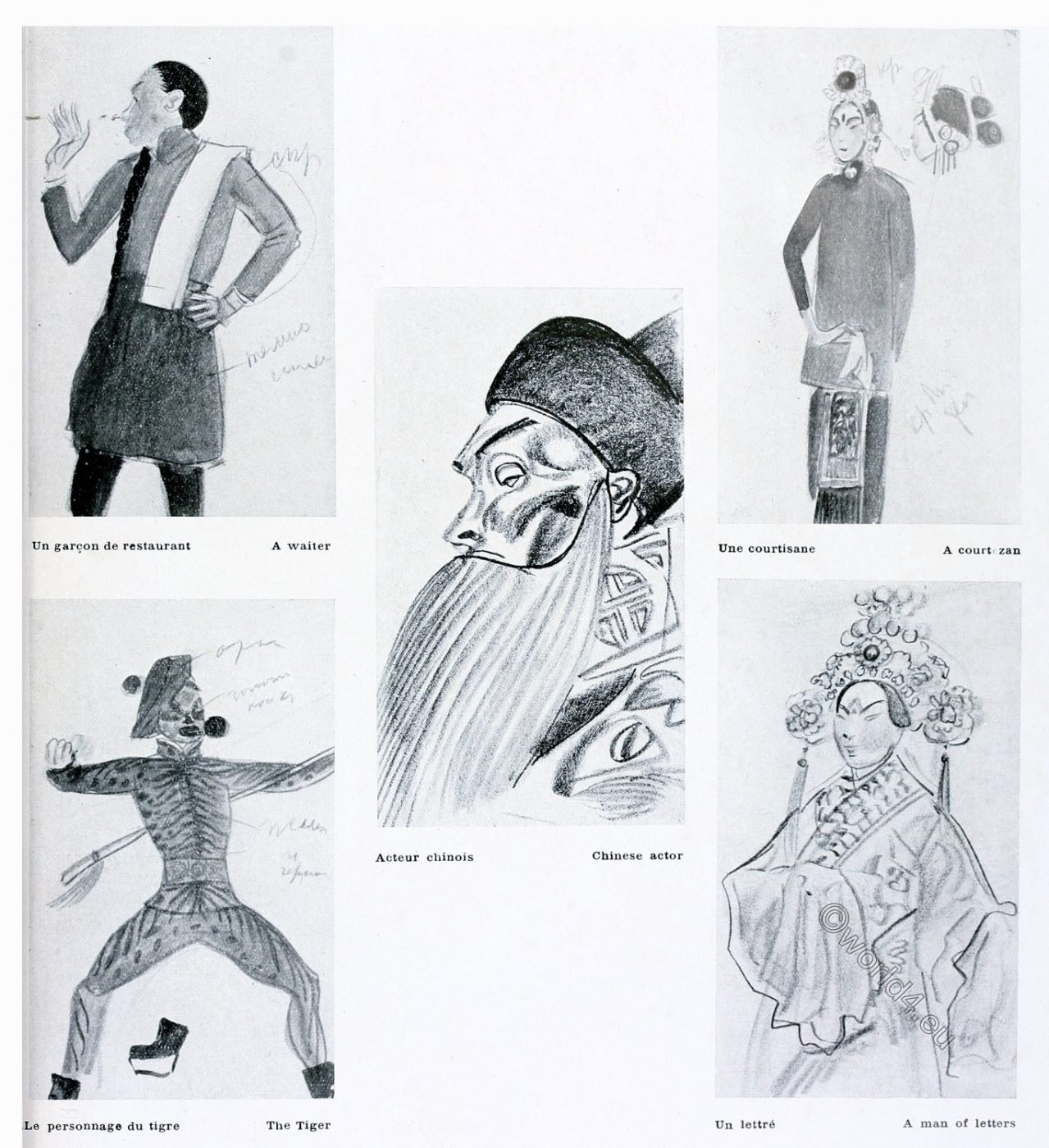
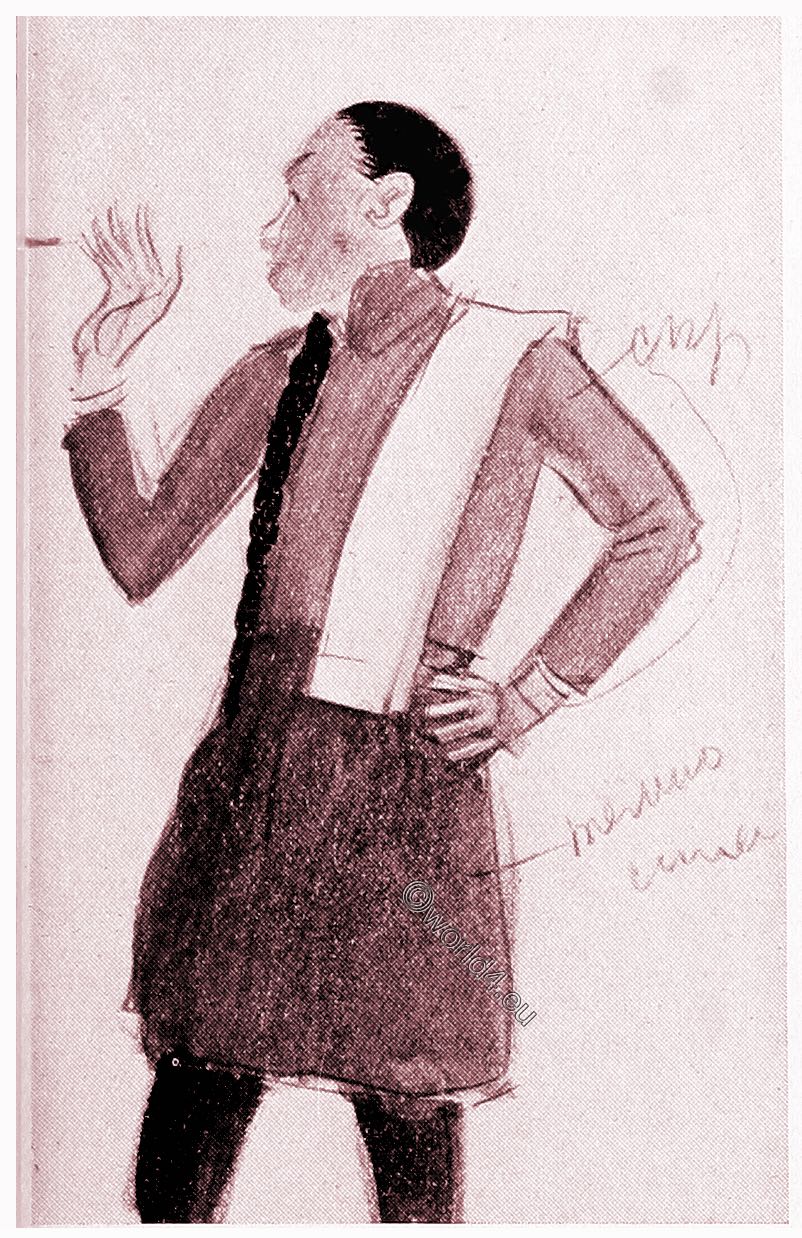
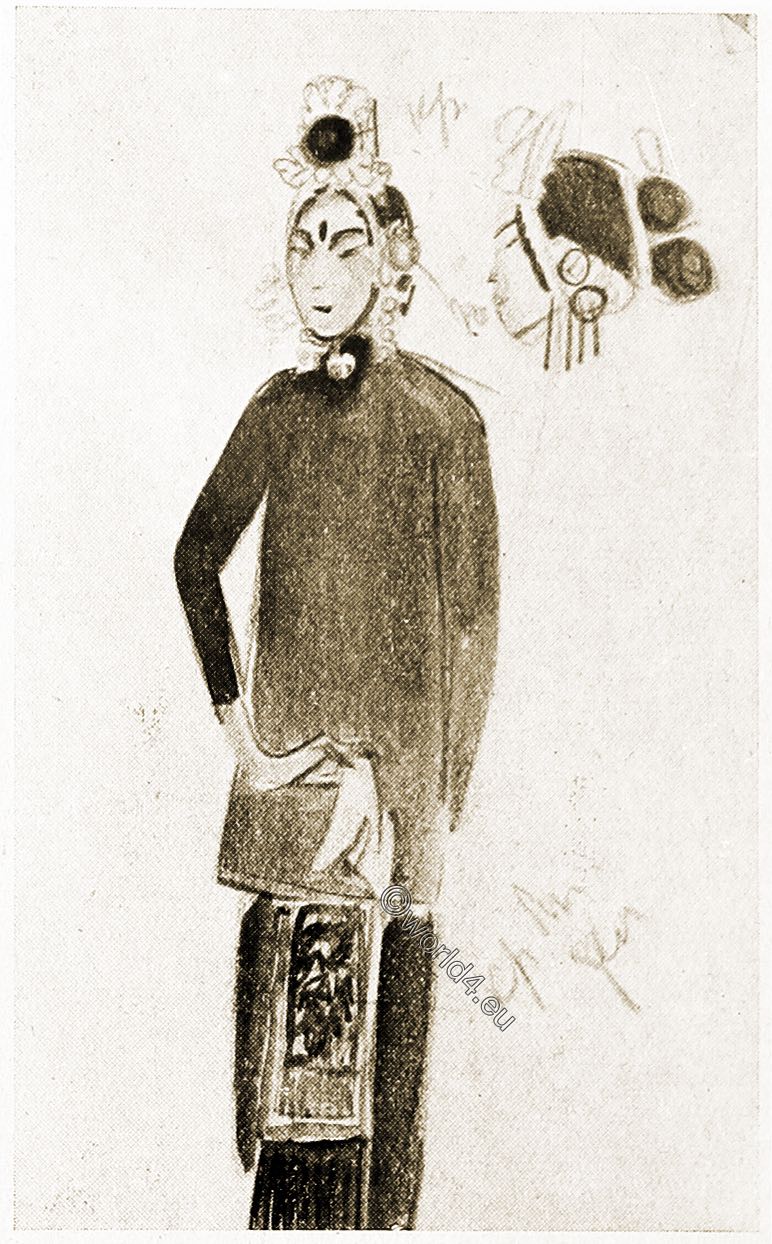
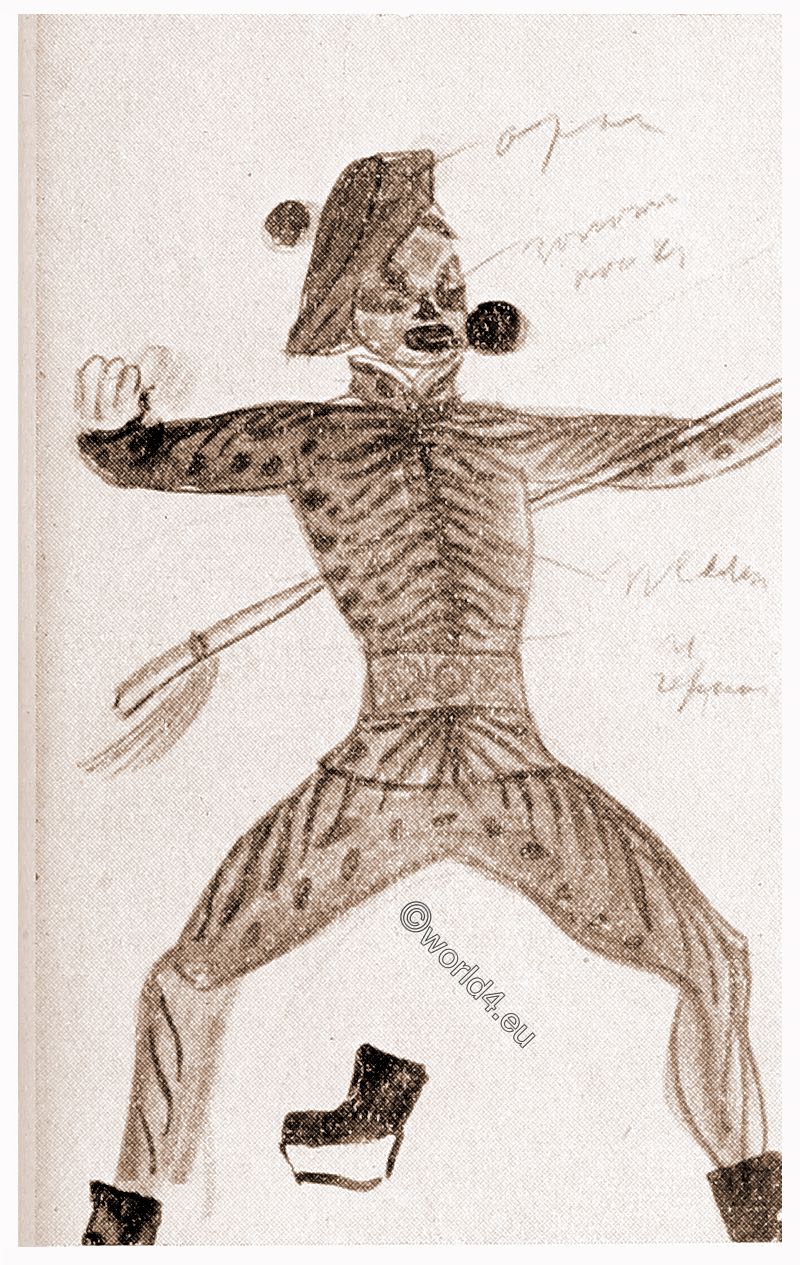
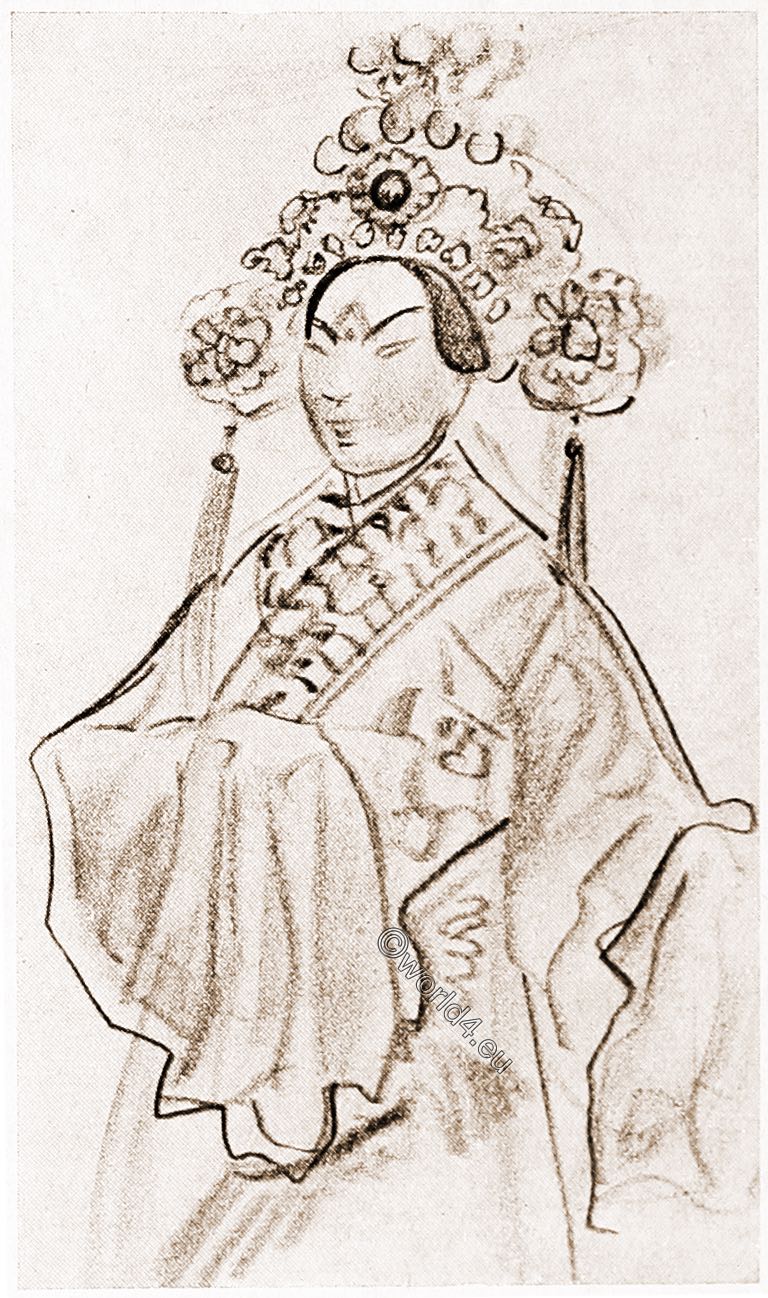
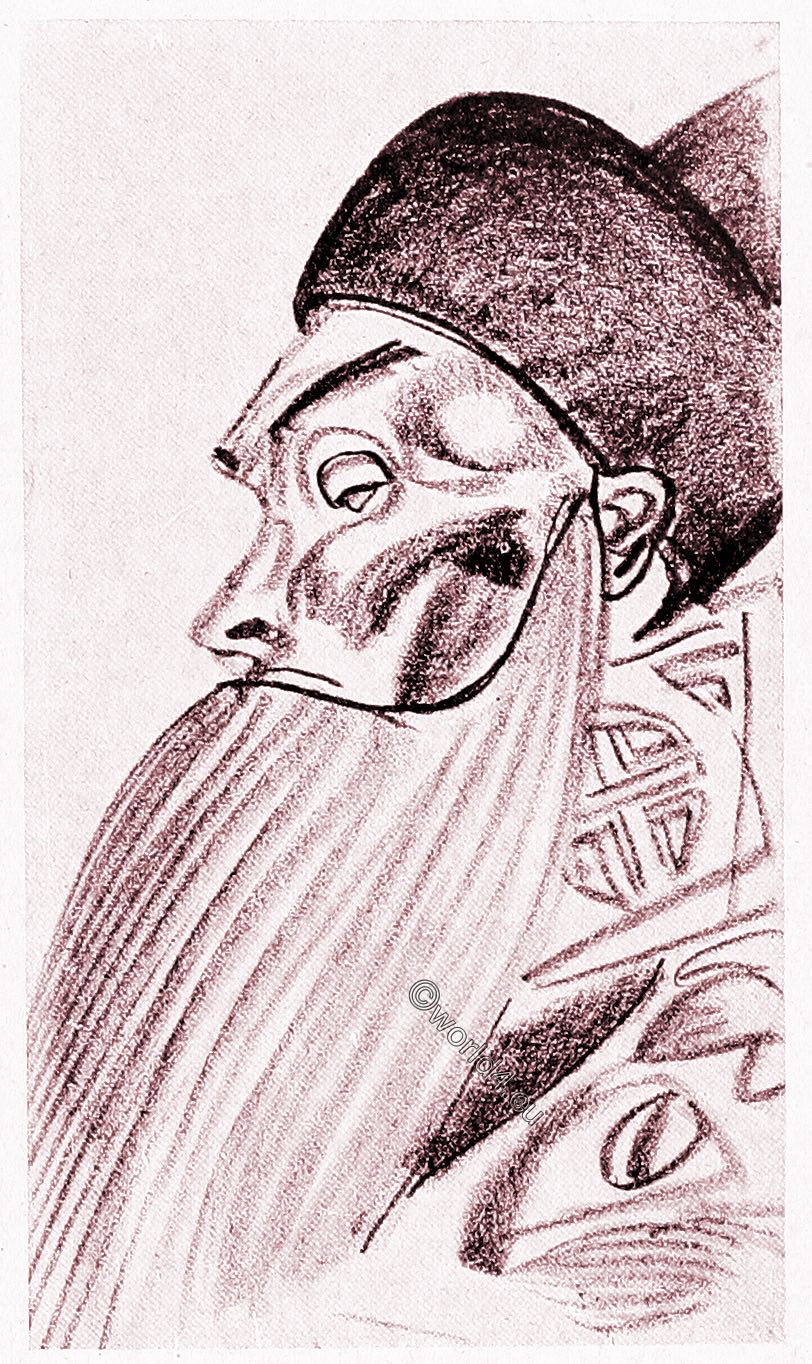
Programmes are usually well arranged, consisting of plays of varied character, comedy being followed by tragedy and music by action, so that variety is assured. The following is a typical programme:
I. The Happy Family.
II. The Marriage of a Fool.
III. The Young Widow in the Cemetery.
IV. Acrobatic scene.
V. The Sacrifice on the Blue River,
VI. The secret Return of General Yang to his Mother.
VII. Shut-lien-tong (mythological play).
ANALYSIS OF THE PLAYS
I. The Happy Family. – I have already stated why this play cannot be of much interest. It is nothing but a commonplace mythological scene, in which appear the god of long life, the god of riches, the god of honor, etc. But it is very decorative, owing to the large number of people on the stage and the beauty of their costumes. From this point of view it is well worth seeing,
II. The Marriage of a Fool is, as the title indicates, a farce which makes the audience laugh heartily. It is unnecessary to give a description of it.
III. The Young Widow in the Cemetery is not a sad story, but merely a merry intrigue. Liou, the man of letters, goes to the capital to obtain an official post while his wife stays behind in her native town.
Owing to the civil wars the wife remains for several years without news of her husband. Thinking that he has been killed, she builds a tomb on which she weeps for him daily.
One day, while she is weeping there, the new governor of the city passes by the cemetery. His attention is attracted by the sounds of lamentation, so he sends one of his servants to see what is the matter and whether it is not a case of some one suffering under an injustice.
The servant returns with the widow, who has a complaint to make to the governor. She wants him to take revenge on the bandit who has killed her husband.
The governor listens to her with keen attention being hardly able to dissimulate his joy. But at last the woman recognizes in him her long, lost husband, and begins to play with his hat and other official insignia, much to the surprise of the governor’s attendants.
The play ends with a comic dance.
IV. The acrobatic scene requires no comment.
V. The Sacrifice on the Blue River is an historic play in which one sees the sister of the Emperor of the Wus lamenting her husband (the future emperor of the Shoo), from whom she is separated owing to the political differences between her husband and her brother. The interest of this play consists in the music and singing.
VI. The secret Return of General Yang to his Mother is a war episode of the end of the Song period, when China was continuously at war with the northern barbarians.
General Yang, who is a prisoner in the hands of the Tartars, despairs of ever seeing China again. His wife is the daughter of a Tartar general and has given him a son. Being the son-in-law of the head of the State, he is very well treated, and he might have been quite happy, were it not for his desire to see his mother again. Without daring to tell anyone, he never ceases to dream of being able to journey to China.
His wife, noticing how sad General Yang is, asks him the cause and promises to help him in his enterprise.
It is necessary for this to obtain one of the golden arrows which are used as sign to pass the military guards at the frontier.
One day when the young princess is in her father’s room with her baby in her arms, the child begins to cry, an the Chief of the State who loves it fondly asks what is the matter. “He wants to play with one of those golden arrows and I will not let him”, the daughter replies, whereupon the father himself gives the child what he wants. At the same moment several generals enter the room and the daughter slips out unnoticed with the child carrying the arrow.
General Yang, who is only waiting for this opportunity to get away, rides off with a trusted servant the same evening, promising his wife to return within a few days.
Some days after the departure of General Yang the Tartar chief asks his daughter to give him back the golden arrow with which her child had been playing. She is about to be severely punished for what she has done when General Yang, who is a man of his word, returns and confesses to his father-in-law the reason which has prompted him to act as he has.
The chief is so moved by this example of the love of a son for his mother that he forgives all and permits General Yang to visit his mother in future as often as he wishes.
VII. Shut-Lieu-tong is a mythological play in which one sees the gods give battle to a genie with the body of a monkey.
CHARACTERS IN THE PLAYS
In order better to understand what follows, especially with regard to makeup and disguises, it is essential first to say something about the traditional characters in the plays. I call them traditional, because in Chinese plays the characters are designated by names which indicate their activities. These designations are either general or specific, the former being five in number.
- Shen is a male character, without make-up except in the case of mythological parts.
- Tsing or Hoa-Lien (flowered face), male personage with make-up.
- Tan, female character without make-up.
- Mo, male character, old, without make-up, and of secondary importance.
- Cheou, comic character of either sex, always with make-up.
Specific designations are too many to enumerate. Suffice it to say that the Tsing and the Cheou are always made up, and that the Shen unly make up in military mythological parts.
COSTUMES AND STAGE DECORATIONS
In view of the fact that Chinese dramas may be set at very different periods and drawn from very wide sources, the costumes worn by the, characters in the plays are extremely varied.
They are divided into three categories:
I. – The ancient national costume.
II. – The modern national costume.
III. – Costumes of foreign countries.
The first of the three are by far the most interesting, and are worn ‘by the majority of actors on the stage. We shall therefore deal with them alone. They are of rare magnificence, and produce a great effect on the eyes of the spectator.
By the variety of their colouring and the richness of their ornamentation the costumes compensate for the poorness of the rest of the stage decorations.
In large Chinese theatres all the costumes worn are of silk, most of them being richly embroidered and covered with metal mirrors.
The social statutes of the characters is not shown by difference in the texture but merely by the style, the colour, and the shape.
A beggar may well wear robes of silk, but they must be made of small bits of stuff of many colours like a patchwork quilt.
Colours play a very important part in differentiating between the various conditions and ranks of the characters. They also serve to mark different conditions of life. It is therefore essential to give their traditional signification.
Red symbolizes joy and dignity. White is the colour of deep mourning.
Black is worn for less formal mourning; it also symbolizes severity and a humble condition in life.
Yellow is the colour of the imperial family, of members of a religious order, and of old women.
Blue is the symbol of honesty and simplicity. Green designates concubines and servants.
Rose is the colour of gaiety and lightness.
It must be understood that these indications are far from being complete and only indicate the general scheme for the use of colours. I have not taken into account the exceptions which are so frequent and of which it is impossible to give a complete list.
If historical or legendary characters have their well determined colours and costumes, it is the novels – chief source of the Chinese drama – which furnish us with precise indications. These the actor s would never venture to ignore.
Before examining the various antique costumes, we must, in order to make our task easier, divide up the characters in the plays into the following categories:
- Male civilian character.
- Male military character.
- Female civilian character.
- Female military character.
The male civilian character wears a long, very wide robe in the form of a kimono, which descends to within a bout ten inches of the ground, one corner being turned back and attached beneath the right arm. The colour of this robe (with or without ornaments) varies according to the social standing of the character represented and to the circumstances. Here are some examples:
A servant wears a black robe, white cuffs, yellow sash, black boots and trousers, octagonal bonnet of the same colour turned down at the side.
A simple civilian wears a blue robe, with white cuffs, without embroidery and without a sash, and a straight black bonnet, blue trousers and black satin boots.
A young student wears a white robe embroidered with flowers, having white cuffs, a two-cornered hat of the same colour and also embroidered, trousers which are hidden under the robe, and black satin boots.
A sub-prefect wears a blue robe with white cuffs, a sash ornamented with white jade, a magistrate’s hat (always black) with two flaps falling onto the shoulders, trousers hidden by the dress, and black satin boots.
A governor of a province wears a red robe with white cuffs, sash decorated with white jade, magistrate’s hat and black satin boots.
An emperor wears a yellow robe embroidered with dragons and having white cuffs, sash decorated with jade, a diadem of chiseled gold, and black satin boots.
Male military characters are divided into:
a) warrior on horse back.
b) warrior on foot.
The former always wears a helmet and a battle costume with metal disks. He often has four little flags attached to his back. Dress and flags are always of the same colour.
The foot warrior always wears an octagonal silk hat ornamented with red, rose, or blue pompon and mirrors. He is dressed in a sort of tight-fitting frock-coat, falling below the waist and showing trousers to match. Black satin boots, an d a silk sash tied in front with gold-fringed ends hanging to the knees, complete the costume.
When not actually fighting, the warriors often wear a big silk cape of bright colour, embroidered in gold or silver.
Female civilian characters wear a shorter and less wide robe than the men, and a skirt only displaying the lower extremity of the trousers. Only women of low standing do not wear a skirt. A servant always wears a long waistcoat covering a tight jacket. The waistcoat is fastened by a silk sash.
Women warriors are also divided into two classes:
a) woman warrior on horseback.
b) woman warrior on foot.
The woman on horseback is dressed in a long robe like that of the man, but smaller. She wears a sort of diadem covered vith small mirrors. Attached to her neck are two pheasants’ feathers, and two foxbrushes which fall round the neck on either side and onto the breast.
The costume of a woman foot warrior is very simple. It consists of a very tight, buttoned vest, and pleated skirt with ribbons.
With regard to the manner in which the hair is dressed on the stage I will say nothing, as the subject would be too long. Suffice it to say that only the men wear hats, while the women are either bareheaded, or have head-dresses consisting of diadems, flowers, ribbons, or jewels, none of which hide the hair completely.
MAKE- UP AND DISGUISES
The mere fact of powdering the face, putting some blue greasepaint around the eyes and some red on lips and cheeks being universal, has no interest here.
The kind of make-up I wish to discuss is of a very special character. It may be termed a sort of coloured mask painted directly on the face.
Its origin is probably the real mask. Its advantage over the latter consists in the fact that it does not hinder speech. It may be of very varied hue, and occasionally, but not invariably, conclusions may be drawn from the colours.
A white mask, for instance, denotes a perfidious statesman.
The red mask is the sign of the upright man.
The black mask indicates a severe and brutal character.
In order to make up, the actors have to follow traditional rules which determine the physiognomy of the personages represented. These rules are purely theatrical and are not mentioned in any book. They are traditional and classic, and are handed down from teacher to pupil. No actor would dare ignore them.
Besides, habitués of the theatre know them too, and they would not stand the slightest infraction of the rules laid down with regard to the traditional make-up of the characters.
An actor making any mistake or in any way altering his make-up from the form accepted by tradition would certainly be received with hostile, derisive shouts from the spectators.
I must point out, by the way, that the make-up of the Shen and the Tsing covers the whole face, while that of the Cheou (comedians) is only partial. When a Cheou plays the part of a comic mother-in-law, his face is covered with a thick layer of powder, he has brilliant red cheeks, a peasant’s head-dress and huge boots.


In the feminine roles which are not of a comic nature the make-up is a very difficult matter, for it is essential to imitate the small feet of the woman. To do this the actors who specialize in these roles (the tan), wear small wooden feet attached to their own. They are in consequence forced to walk on tiptoe during the whole of their part, just like ballet-dancers.
This task becomes still more difficult in the case of impersonating female warriors, when the actor is forced to execute all sorts of perilous jumps. Accidents are nevertheless never recorded.
SOME SYMBOLIC AND REPRESENTATIVE OBJECTS
I have already stated that on the Chinese stage the scenery and setting are very simple, and that certain things are left to the imagination. It is therefore necessary to make the spectator imagine the presence of :these things by means of certain conventional objects.
Here are some examples:-
- The whip represents the horse.
- A flag decorated with a fish represents water.
- Two flags, each with a wheel, represent the cart.
- A blue curtain with white lines indicates a rampart.
- Two panels ornamented with rocks represent mountains
- A cube wrapped up in yellow silk represents a magistrate’s seal.
- A parcel wrapped up in red cloth represents a human head.
- A fly-flap is the symbol of purity and religion, and of spirits.
- The fan is the sign of frivolity and extravagance.
SOURCES FROM WHICH THE PLAYS ARE DRAWN
Although the majority of Chinese plays is without doubt drawn from the history of the country, the direct source is the historic novel, which has served as a kind of intermediary between history and the stage.
There is an interesting novel dealing with each period of history, from which dramas are taken. As model one may well site San-kuo-yen-yi (the Story of the Three Kingdoms).
There are, of course, many different kinds of historic novel, and their subjects vary, dealing with love, travel, social conditions, religion, mythology, superstition, brigands, etc.
Most of these novels are masterpieces. Every Chinaman loves to read them or to listen to their being read aloud. As a result the personages and incidents, whether real or imaginary, are ever fresh and alive to him.
One principle stands out from all these novels: right is greater than might. And as the plays are drawn from the novels, the same principle reigns on the stage. The good are ever recompensed, the wicked punished, the innocent vindicated and the guilty executed.
As for the characters of the plays, these are drawn from every class of Chinese society. Only the characters in plays which are pure fiction are created by the imagination of the author.
CONCLUSION
I have tried in this short story of the Chinese theatre to explain to my readers its three important aspects and to give them an idea of its moral, artistic and musical importance.
In view of the severity of Chinese morals all plays must be inspired by the highest sentiments; never could a play of doubtful or risqué character be presented on a public stage without offending the inherent sense of modesty of the spectators. This sense of modesty is pushed to such an extreme that, unlike in the European theatre, love only plays a very small and secondary part in the plays. Dancing for dancing’S sake is also unknown to the Chinese stage. But this absence of the love interest just alluded to does not in any way mean that women are banished from taking an important part in the plays. Indeed no theatrical program would be considered complete unless it included a play in which the principal part was that of a heroine. Only the part of that heroine is usually played by a young man in disguise.
Owing to these disguises and to the fact that he receives no support from scenic effects, the task of the Chinese actor is more difficult than that of his European colleague. To say nothing of the long preliminary studies which are required in order to imitate with accuracy the voice, gestures, walk and general attitudes of a woman, it is easy to conceive the difficulty of interpreting correctly to the spectator the sentiments felt by the opposite sex.
When opening or shutting an imaginary door, when throwing an imaginary stone, twisting a non-existent thread, or sewing an invisible dress, the actor does it all with such precise gestures that he produces on those who watch him an absolute sense of reality.
When he pretends to jump on the back of a horse or to rub it down, one actually, so to speak, sees the horse. When he imitates the movements of one rowing against the rushing river current, one feels the flowing waters and the rocking of the boat. It is, therefore, no exaggeration to say that the art of gesture is particularly highly developed in the Chinese comedian.
Of course it must be remembered that all these gestures and actions are supported by the sound of music which is so combined as to synchronize perfectly with. each one of the actor’s movements. It is thus easy to understand the importance of the orchestra in the Chinese theatre, as the music does not merely accompany the actor, but regulates his walk, punctuates his speech and marks his very movements.
It may in truth be said that a Chinese play is a sort of dance, animated by various sentiments, accompanied by song and dialogue, and executed to the sound of music.
Source: The Chinese Theatre by Chu Chia-Chien. Illustrations by Alexandre Jacovleff. London: J. Lane, 1922.

